Aadya Baoni
|
December 29, 2025
|
9
min read
Gujarat’s stepwells are reservoirs of ancient water wisdom and meticulous design
These climate-smart ancient structures have lessons for India’s present and future
Read More

As bees, moths and flies make a quiet exit, their absence will directly impact crop resilience and yield quality
Editor's Note: The planet we inherited as children is not the planet we will someday bid goodbye to. The orchestral call of cicadas in the evenings, the coinciding arrival of the monsoon with the start of the school year, and the predictability of natural cycles—things we thought to be unchanging are now at risk. An altered climate, declining biodiversity and warming oceans aren’t distant realities presented in news headlines; they affect us all in seen and unseen ways. In ‘Converging Currents’, marine conservationist and science communicator Phalguni Ranjan explores how the fine threads connecting people and nature are transforming with a changing planet.
Think back to when you were a kid. Do you remember tiny bugs sticking to your t-shirt when you played outside, just as dusk creeped in? Or tiny, black bugs splattering an abstract painting on the windshield of your parents’ car?
Can you recall when they began to vanish, from our clothes and the walls of our homes?
Think of a world without insects. No buzzing bees, fluttering butterflies, or industrious beetles. It sounds improbable—insects are the most abundant group of animals on Earth—but it is happening. We do not notice it until one day, we suddenly realise that the windshield has been bug-free for far too long.
I remember an abundance of fireflies, noisy cicadas, different kinds of ladybird beetles, and many beehives from my childhood—all of which seem to be vanishing, now.
But what does that mean for us?
The Earth is home to an estimated 8.7 million species of animals and plants, and insects make up around 80% of that figure! Sadly, around 40% of all insects are at risk of extinction, not counting those that are already lost to science and us. A study recorded a 76% decline in flying insect biomass in Germany’s protected nature areas over 27 years, sparking global concern over insect declines and a possible ‘ecological Armageddon’.
Insect pollination supports nearly 75% of global food crops to a great extent, though only around 35% of production (by volume) depends on pollination. However, insect-pollinated crops tend to have higher yield, quality and nutrient content, making them financially and nutritionally more important, especially in developing nations.
Without insect pollinators, certain staples like wheat, rice, and maize would still grow, but a wide variety of fruits, vegetables, nuts, and seeds would suffer, reducing yields by about 5% in high-income countries and 8-10% in low-to-middle-income countries.
Interestingly, 40% of the global nutrient supply comes from animal-pollinated crops, insects included. We could lose many crops for fibre, fodder, dietary supplements, timber, and of course, food. A 100% loss of pollinators could reduce global supply of fruits by 22.9%, vegetables by 16.3%, and nuts and seeds by 22.1%, threatening food security, worsening nutrient deficiencies, and destabilising ecosystems—a process already underway.

The consequences go well beyond food. These tiny critters—especially the helpful, non-pest species—play a critical role in several ecosystem processes like soil formation, nutrient cycling, decomposition, and biological pest control; all vital for agriculture and the ecosystem. Insects also form the base of the food web for several smaller animals and their declines can further drive bird, amphibian, and small reptile declines—essentially anything that feeds on insects.
Without insect pollinators, certain staples like wheat, rice, and maize would still grow, but a wide variety of fruits, vegetables, nuts, and seeds would suffer, reducing yields by about 5% in high-income countries and 8-10% in low-to-middle-income countries.
Pollinators, especially insects, in India are under pressure from multiple directions. Recent surveys show that bees are not the only insects under threat. The iconic fireflies have declined by 76% across the country, and eight species of dragonflies have gone locally extinct in the Western Ghats in Maharashtra. Observations also suggest several species of flea beetles, longhorn beetles, and damselflies have been lost to science in the last few decades, but a lack of comprehensive data makes it difficult to track these declines accurately.
Widespread, indiscriminate pesticide use is one of the biggest threats to these insects, with neonicotinoid (or neonics) pesticides standing out as major culprits. Neonics make up around 40% of the global pesticides market. While they are more effective as pesticides, they linger in water and soil; they are also toxic to the small animals that feed on insects.

Widespread, indiscriminate pesticide use is one of the biggest threats to these insects, with neonicotinoid (or neonics) pesticides standing out as major culprits.
Pollinators also face mounting pressure from habitat loss due to expanding commercial farms, cities, and deforestation. Climate change further disrupts the timing of flowering and pollinator activity. Stresses from invasive species, transgenic crops (with artificially introduced foreign genes), diseases, pollution, and urban light disturbance add to the problem. Urban light pollution is caused by the excessive use of bright artificial light at night that interferes with the natural rhythms of birds, insects, and even humans, causing confusion, disorientation, and sometimes disrupting natural migration pathways.
Also read: No monkeying around on this kiwi farm
India is a predominantly agrarian country, with agriculture supporting the livelihoods of over 42% of our population and contributing over 18% to the GDP. Naturally, this makes the decline of pollinators a serious concern for productivity, livelihoods, and food security.
The country’s rich pollinator biodiversity—over 700 bee species along with several more butterflies, moths, and flies—is vital for crop and forest pollination. Their declining numbers will lead to lower and poorer quality yields, higher labour costs for manual pollination, and weakened crop resilience. Nutritionally, reduced availability of micronutrient-rich foods like fruits, vegetables, and nuts can worsen hidden hunger through micronutrient deficiencies, with major implications for public health.
Fruits, oil seeds, fibres (like cotton), vegetables, ornamental plants, condiments and spices all depend on pollinators. In 2017, insect pollination contributed around USD 22.5 billion or Rs. 1,12,615.7 crore to India’s agroeconomy—a figure that has likely risen since.
However, the problem is much more nuanced. Growing food demand drives the use of more pesticides, fertilisers, and fungicides to increase yield. Land conversion for aggressive agriculture and a push to capitalise on cash crops further reduces habitat diversity and availability. Though these inputs raise yields in the short term, pollinators pay the price in the long run, with compounding toxicity and habitat loss. Climate change-related seasonal irregularity adds another complication. In nature, periodically occurring biological events like flowering and reproduction depend on environmental factors like temperature and light duration. Climate change is disrupting regular seasonal and climatic patterns, and the pollinators are unable to synchronise their arrival with the shifting flowering periods—a phenomenon called phenological mismatch.
Ideally, we need to shift toward farming practices that not only sustain production and livelihoods, but also protect biodiversity. While there is much to learn from global examples, India’s unique challenges—shaped by population, climate, geography, and socio-economics—mean that solutions must be tailored locally.
For most of us, insect decline is a reality we are comfortably buffered from. However, for farmers, it is starker and gloomier—it is a question of their livelihoods. Bee declines in Uttarakhand have pushed farmers to use artificial pheromones in their apple orchards in a desperate bid to attract bees. While manual (or physical) pollination exists, it is labour and time-intensive, and not always a logistically viable option. Across the world and in India, farmers are now renting bees from beekeepers for assisted pollination—a very lucrative and growing business for beekeepers, but one that might make affordability a problem for small-scale farmers. Now, new-age robot-assisted and drone technologies are also being explored to boost pollination, but these still remain in the development stage, with operational constraints.
The United Nations Environment Programme (UNEP) advocates for food systems that work with nature for more resilience, as agriculture is likely to be severely impacted by climate change. Evidence from some Indian farms echoes this, showing that nature-aligned and biodiversity-focused practices can restore insect populations while maintaining healthy yields.
Across the world and in India, farmers are now renting bees from beekeepers for assisted pollination—a very lucrative and growing business for beekeepers, but one that might make affordability a problem for small-scale farmers.
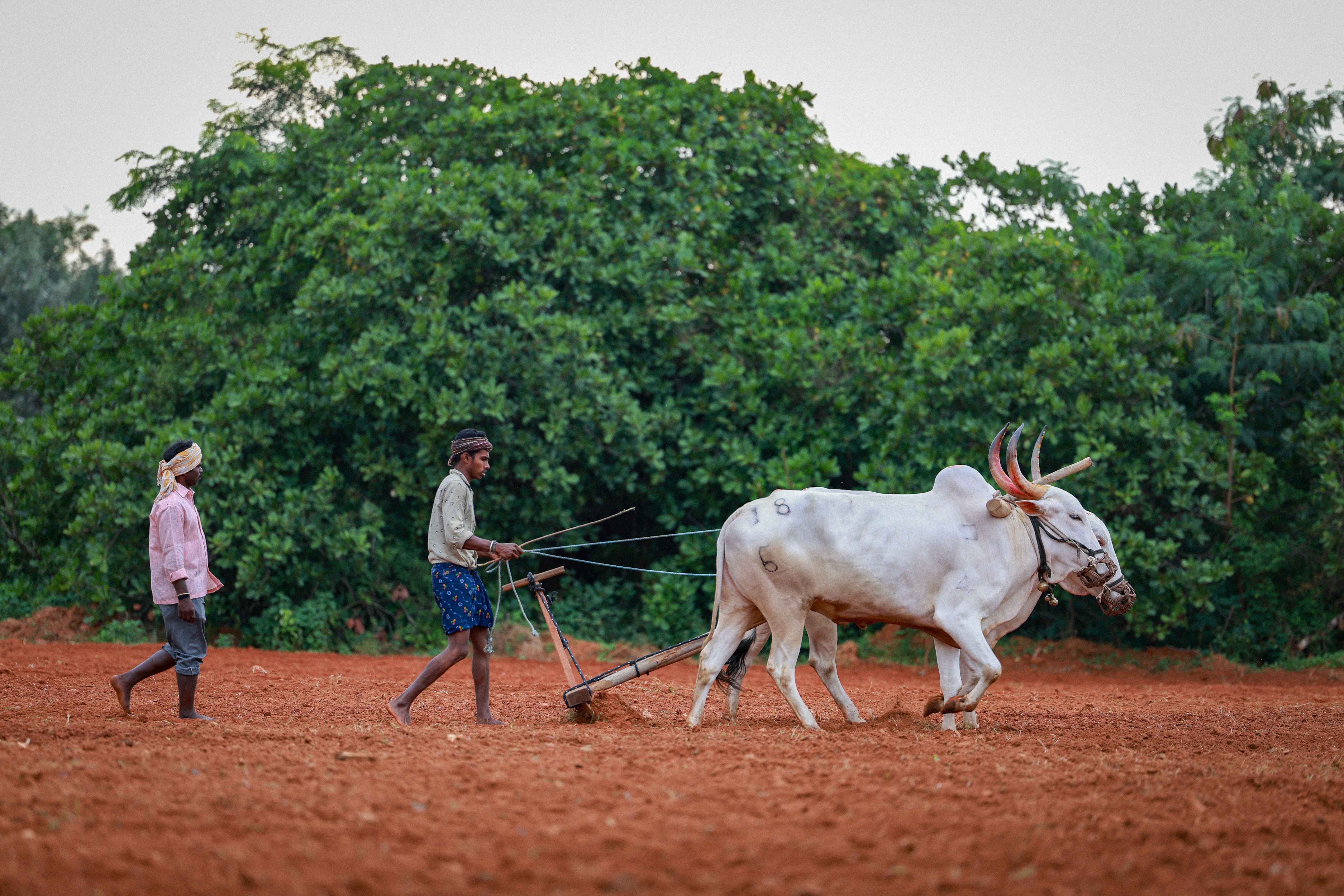
Zero-budget natural farming (ZBNF) is a grassroots agroecological farming method that avoids synthetic fertilisers and pesticides. Instead, the process promotes the use of natural inputs and mulching to improve soil health, increase yields, and reduce farmers’ costs. Research shows that ZBNF has improved yields on several farms in Karnataka and Andhra Pradesh, with notable gains in crops such as rice, chilli, and cotton, while reducing production costs. These farms were also found to support 30-50% higher insect species richness (large numbers and large diversity), including 2-3 times more pollinator species and natural predators, while boosting the farms’ resilience to climate shocks, when compared to chemical-based farms.
Building on ZBNF, the Andhra Pradesh Community Managed Natural Farming (APCNF) movement promotes nature-based farming by integrating livestock, organic residues, plant-based pest control, and crop diversification. Farmers also install bird perches and crop border strips, enhancing habitat for pollinators and birds. Compared to chemical farms, these fields show healthier soils, with observations noting the return of birds to the landscape.
Also read: Farming under the elephant's nose: Lessons in crop choices
Change is possible. Organic farming is catching on in India; Sikkim was declared the world’s first all-organic state in 2016, having phased out chemical pesticides, fertilisers, and GMOs completely. Farmers across West Bengal, Karnataka, and Andhra Pradesh are adopting nature-integrated agricultural practices to restore soil health, and boost food security and climate resilience while preserving biodiversity. Such nature-aligned farming practices can help boost pollinator numbers by reducing toxic pesticides, and increasing availability of more diverse and healthier crops (and thus, pollen and food).
However, widespread adoption requires training, funding, and policy support. We need more robust science, collaborative action, and stronger policies to fuel community-based initiatives that bring farmers, scientists, and policymakers together.
There are small things we can do as well. Urban light pollution causes significant disturbances to insects’ circadian rhythms and nocturnal migrations, and swapping out blue lights (which can affect people too) for warmer and softer yellow lights can help.
Protecting pollinators is not just about saving insects or preserving biodiversity. It is finding a solution to a complex multi-level problem; one that involves our food, economy, livelihoods, and the resilience of the ecosystems we all depend on.
Artwork by Radha Pennathur, Communication Designer & Illustrator
{{quiz}}
.png)
From earthworms to dung beetles, the agricultural landscape and its thriving soil features a diverse set of agents
Editor’s note: To know Rama Ranee is to learn about the power of regenerative practices. The yoga therapist, author and biodynamic farmer spent three decades restoring land in Karnataka, envisioning it as a forest farm in harmony with nature. In ‘The Anemane Dispatch’, a monthly column, she shares tales from the fields, reflections on the realities of farming in an unusual terrain, and stories about local ecology gathered through observation, bird watching—and being.
A freshly dug up mud bank where wild pigs foraged for tubers on their nightly jaunts; burrows under the compost heap where a slinking mongoose sought earthworms; the barely perceptible rustling under a heap of fallen leaves and the scurry of tiny roaches and millipedes—all of it makes the soil what it is, a matrix where substance and processes are indistinguishable.
Living soil is a complex world of decomposed organic matter, a host of micro- and macro-organisms, bacteria, fungi, nematodes (a free-living worm of the phylum Nematoda), worms, insects and rhizosphere (the volume of soil in proximity to root segments). This dynamic universe is brought alive by their interactions. Occasionally, if we choose to lower our gaze, terra firma’s curtains rise, revealing actors who—for the most time—remain backstage, or to be precise, underground.
Also read: Farming under the elephant's nose: Lessons in crop choices
A large snail shell tottered down a slight slope, almost as if it had a life of its own. That it was a perfectly empty shell devoid of all signs of life was intriguing. It must have belonged to a long dead Giant African Snail but was now being repurposed by an ingenious Dung Beetle. The shell was two inches big, and the beetle less than one-fourth its size, explaining the struggle to get it across to I-don’t-know-where; half-dragging, half-pushing into a semi-roll, in a heroic effort.
After a lapse of 15 minutes, the bug and the snail shell had made foot-long progress, and this time, the direction had changed. Instead of down the slope, it was up! When I came back to the spot after an hour the project had been abandoned, the shell lying by the wayside, unclaimed.
Dung Beetles are a treat to watch. When they find fresh cow dung, they roll bits of it away towards their nests in tunnels as brood balls, where eggs are laid and young ones raised. The adults feed on the moist, nutrient-rich contents, while the larvae hatch and feed on the fibrous residue, ingesting the coarse, undigested plant material populated with bacteria and fungi. Elephant dung, too, is much coveted by these beetles.
Dung Beetles are a treat to watch. When they find fresh cow dung, they roll bits of it away towards their nests in tunnels as brood balls, where eggs are laid and young ones raised.
It is evident that Dung Beetles contribute to the health of the soil as primary decomposers—recycling nutrients, improving soil structure and water retention. Their tunneling aids aeration and water percolation. By consuming fresh dung efficiently, they prevent pests like dung flies from multiplying, a natural pest control measure. Another important role is that of secondary seed dispersers; they bury seeds and save them.
I have acquired a perpetual crick in the neck while walking, as I watch out for ant armies marching in the grass. Tree trunks, bamboo clumps, leafy branches, stems of plants, in the ground, and of course, in the kitchen—they are everywhere. These ubiquitous beings have a deep connection with the soil; those who dwell in it are essential shapers of its quality and health.
Recently when the sun shone bright, after a rainy spell, little Black Ants were tunnelling, lifting granules of grit, and placing them precisely around the periphery. Another team of ants garnered seeds of amaranth from the ground—remnants of a harvest. After a while, a mound grew with a fine lining of amaranth seed hull discarded from the tunnel. The tiny seeds had been expertly hulled and stored away for the future. No wonder Black Ants are revered by our farming community.
Marvelling at the ants, farmhand Rajappa shared a story as narrated by his father: there was once a terrible drought where farmers lost all their crops. Even the hardiest ragi withered in the fields. Finally, when the clouds gathered and the rains came pouring down, the farmers tilled their fields. To their utter dismay, no one had a grain of ragi to sow! Despair turned to wonder when armies of black ants emerged from their tunnels with perfectly preserved grains and heaped them onto the fields, for the farmers to sow. Since that day, they are revered as farmers’ saviours with offerings of rice. Every morning, Nagarajappa—our cattle vaidya can be seen making his offerings to the Black Ant.
Their presence in the soil is beneficial in many ways, from the control of potential insect pests like beetle grubs and termite larvae by predation, to inhibiting pathogens by scavenging dead organic matter including carcasses and fruits.
The industriousness of Little Black Ants (Monomorium minimum) is upheld as an example to impressionable young children through fables like Aesop’s The Ant and the Grasshopper. Their foraging behaviour is ecologically significant, contributing to the dispersal of seeds of wild plants. We have found that the propagation of most wild edible greens is best left to nature, but how these delicate seeds endured harsh weather was a mystery. We apparently owe their survival to the Little Black Ant!

A decade ago, before the ground became a mantle of grass, ant columns and nests were visible. The lemon trees were beginning to bloom, but the floor in the interspaces was bare and dry. As if marking the centre was a neat, elevated mound of tiny pebbles and feathers belonging to slender greyish ants in a subterranean nest. I had, in all probability, come upon the nest of the Sri Lanka queenless ant (Diacamma ceylonense), common to our island neighbour and south India.
The Bannerghatta National Park with its deciduous forests, where the Anemane Farm is located, is home to this soil-dwelling ant specie known to use feathers around its nest. The feathers are a decoration with a purpose: to trap dew for water supply, as a camouflage to conceal the entrance, and as a protective barrier from predators.
Their presence in the soil is beneficial in many ways, from the control of potential insect pests like beetle grubs and termite larvae by predation, to inhibiting pathogens by scavenging dead organic matter including carcasses and fruits.
Though two species are mentioned here, there are several others whose identity I cannot establish. A study of the adjoining area indicates a significant diversity. The ecological importance of soil-dwelling ants is immense:
· Balancing insect populations, which are potential pests, ensures soil health
· Their antimicrobial secretions inhibit soil pathogens, maintaining a hygienic environment around the nest
· Their tunnels are repositories of nutrient-rich organic material which, upon decomposing, enriches the soil
· The constant moving and mixing of soil particles from different depths improves soil texture and fertility
· The underground galleries create pockets which aid aeration and water drainage
· Seed dispersal occurs through mutualism (myrmecochory, or a seed carrying partnership) between the plant and ant
· Seeds with nutrient-rich structures (elaiosomes) that are an attractive food source, are collected. After consuming the protein-rich, fleshy parts, the seeds are disposed in nutrient-rich soil where they may germinate.
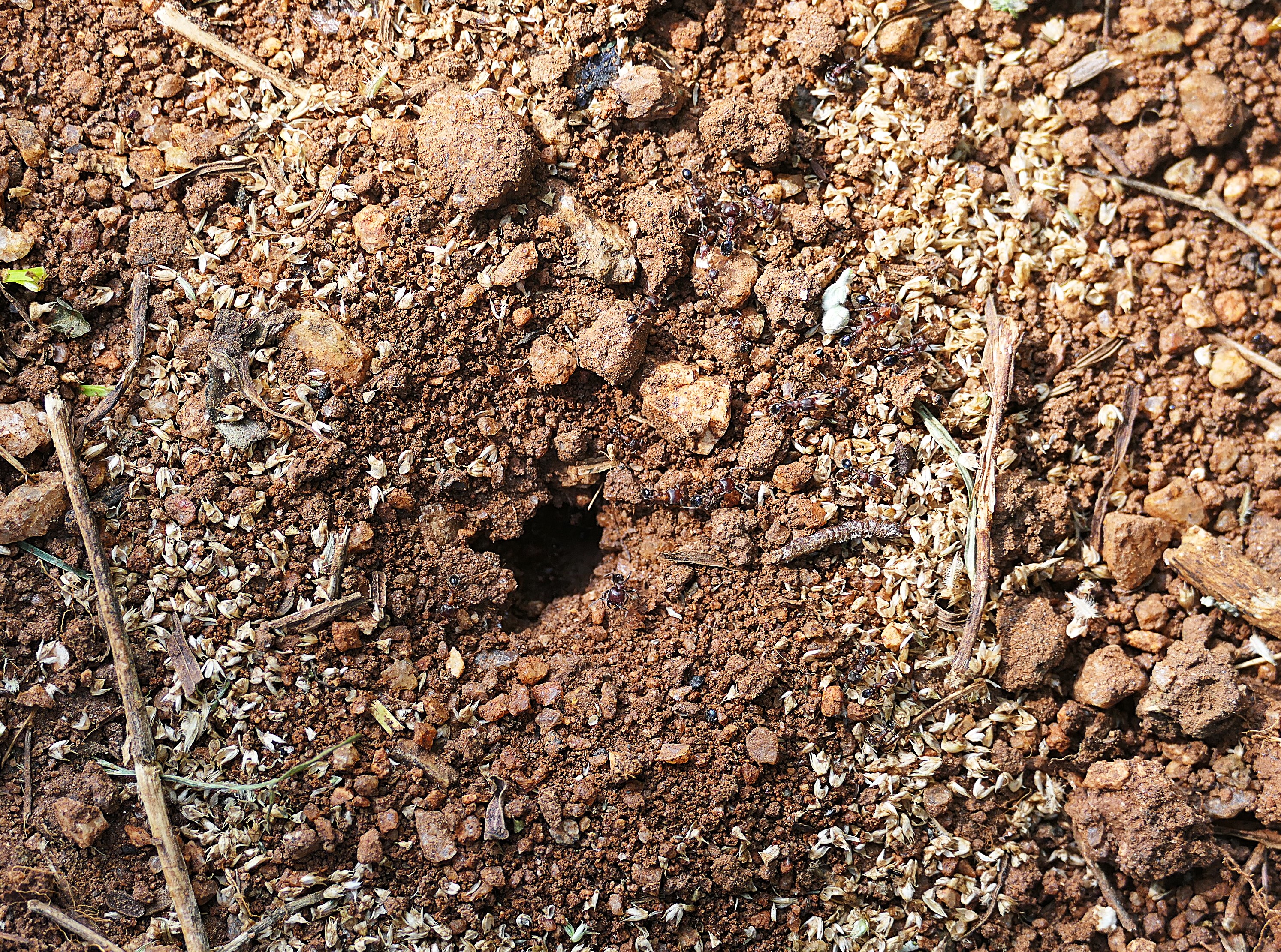
Also read: How birds open a window to the shared web of life: our ecosystem
Often dreaded for their uncanny ability to find and destroy wood or anything else with cellulose, termites are both, a threat and a blessing, depending on the situation and whether we are in the thick of it ourselves. Not merely trees or vegetation, but even human habitation—especially mud-plastered walls, wooden beams, any ‘untreated’ wooden surfaces, fabric, and paper—is under risk in some environments.
The redeeming fact is that termites are attracted to dead or decaying wood, including trees affected by decay fungi. A healthy tree may stand untouched and unaffected amid termite infestation. A tree may be stripped off its decayed bark, dead limbs and heartwood and continue to thrive, if part of the sapwood and cambium—the living tissues—are intact, as has been the case with one of our citrus and Jamun trees. Recycling nutrients through the decomposition of lignin, one of the toughest natural materials to breakdown, is a vital ecological service provided by termites. As ecosystem engineers, they create fertile islands of enriched soil by digesting and redepositing soil particles combined with decomposed organic debris. Termite ‘reconstituted’ soil is rich in organic carbon, nitrogen, and phosphorus.
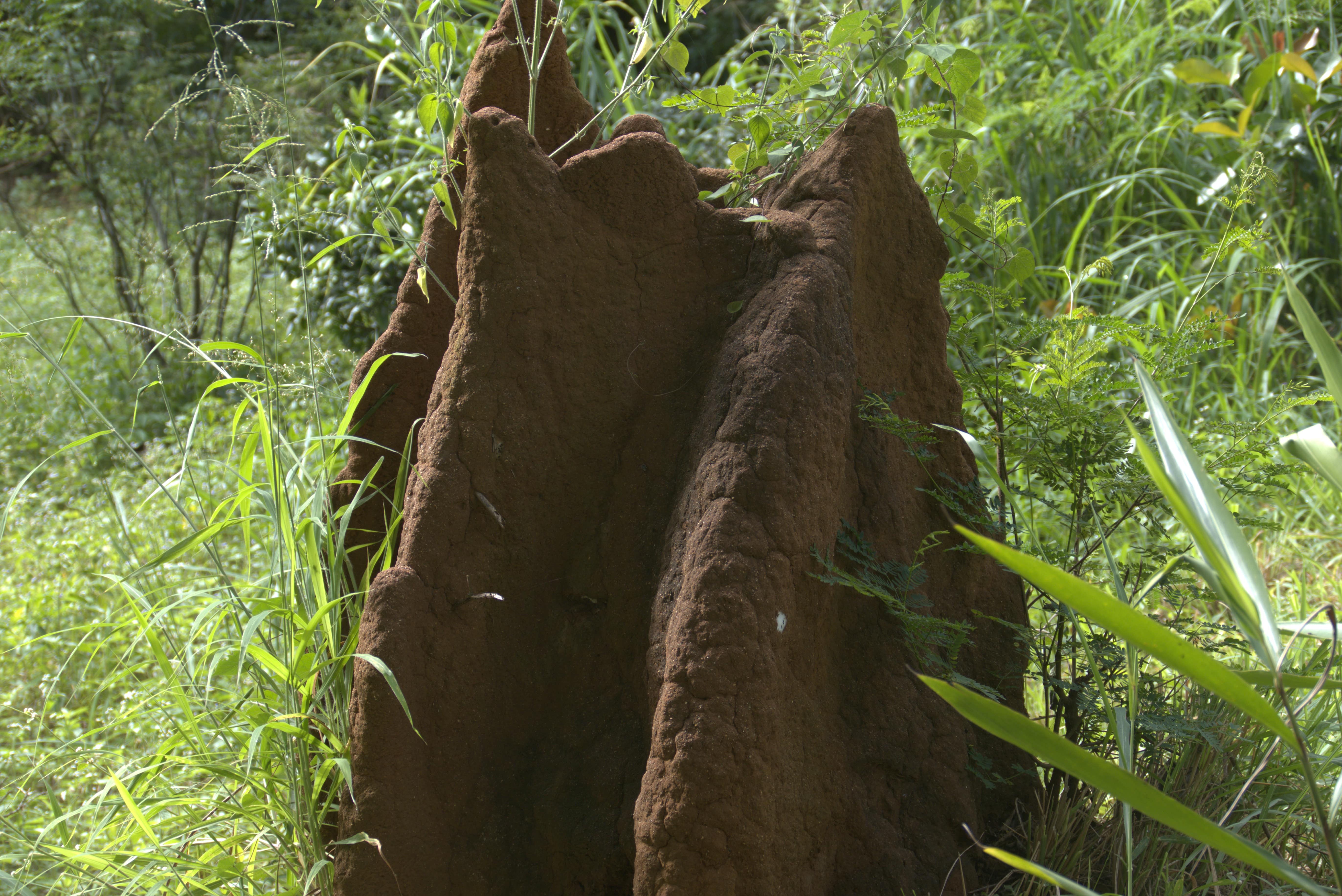
Subterranean termites which build cathedral-like mounds (species of Termitidae) shape soil hydrology. The mounds are connected by a labyrinth of underground tunnels and complex galleries, creating spaces that aid the percolation of water. Traditionally, mound sites were considered as indicators of potential water sources, but exploitation of deep aquifers may have disturbed the balance, rendering this knowledge redundant, a hydrologist informed us while divining (locating groundwater). Despite these human-led disturbances, the insects continue to act in their inimitable way as trusted agents of nature. Mounds are located above water sources as these insects regulate humidity and temperature within the mound to maintain ideal conditions. During the dry season, they transport water from deeper levels reaching the water table.
It is amazing to see how quickly a damaged tower is repaired! Cattle and elephants often enjoy butting against the mound, knocking down parts of the tower. One would expect the mound to be abandoned gauging from the apparent lack of activity. Yet, the following day the tower stands, damage repaired, the damp earth being the only sign that the inhabitants are alert. When a mound is neglected for more than a few days, we can be certain that it has been abandoned.
With its rigid walls, the mound is a masterpiece of architecture that meets its every need—the outer mantle, central nest with nursery rooms, fungal ‘garden’ and royal cell for the queen, and an elaborate system of tunnels and chambers. It is ingenious, not merely due the intricate design and structure, but also for its built-in temperature and humidity regulation. It is a castle that breathes and ventilates naturally, influencing the soil micro-climate in the immediate vicinity.

Just after May showers, we scan the base of mounds hoping for a harvest of the large, satin-smooth Termite mushroom, a specie of Termitomyces. Thick and fleshy with a distinct aroma, these mushrooms make for the best curry we have ever eaten. The mutualism between Termitomyces, farmed in fungal greenhouses as in-house food resource, and termites is a boon as it enhances nutrient concentration in the surrounding soil. The ecological impact of termite activity involving physical, chemical, and biological processes makes them partners in the restoration of degraded lands. Their towers dotting the landscape are a part of our story, too.
It is a castle that breathes and ventilates naturally, influencing the soil micro-climate in the immediate vicinity.
Also read: What it takes to breathe life into degraded farmland
Coiled pellets of soft earth tell tales of earthworms living their lives, weaving through the layers of soil and biomass. The earthworm is the proverbial ‘friend of the farmer.’ There are several ‘friends;’ species which are not so easy to identify, considering they are confined to the deep mineral layers and are seen only when we dig deep. The two most familiar ones are the horizontal burrowers that live in the soil (endogenic), whose castings I find on the vegetable beds or in the basins of fruit trees, and the composters in the vermicompost pits that live in the top organically-rich layers (epigeic).
The earthworm is the proverbial ‘friend of the farmer.’
While they burrow, endogenic earthworms draw dead organic matter such as leaf litter into the soil, feeding on organic matter, soil and on decayed plant roots. They make the farmer’s task easier by improving tilth and fertility, soil structure, aeration, drainage, and aggregation, increasing the capacity to hold moisture—conditions ideal for plants to put down healthy roots. Organic waste and fine soil passing through the gut as castings are rich in enzymes that break down organic matter, act as pest protection, and provide natural hormones conducive for growth. Leaf composts such as biodynamic mixed leaf composts and mulches are effective ways to attract these earthworms. In a sense, they are in-situ composters!
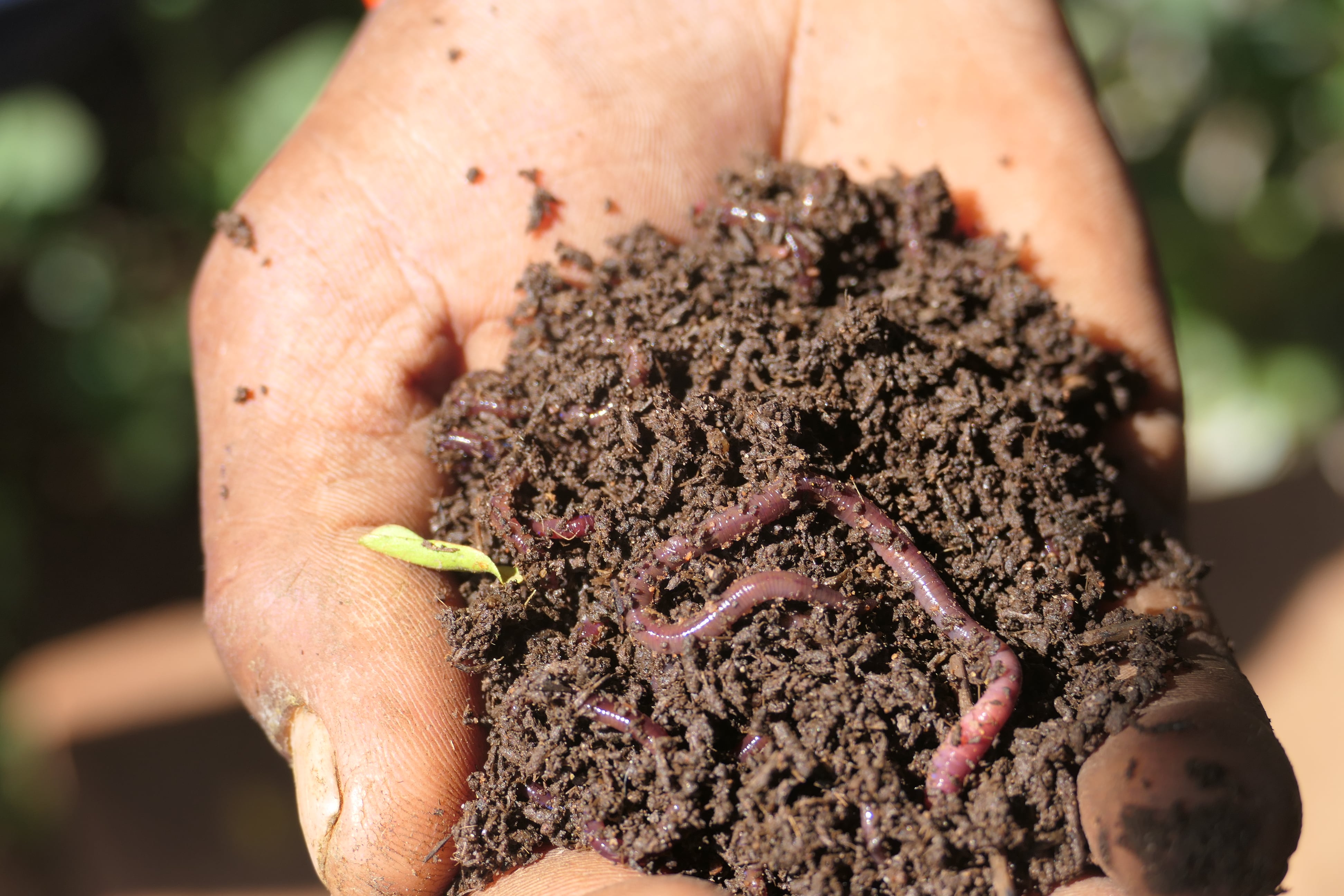
Epigeic earthworms such as the African nightcrawler (Eudrilus eugeniae)—the ones used to make vermicompost—convert animal dung and biomass into a fine silky, smooth substance; a component of humus, deposited on the surface of the compost. They are voracious feeders with a ‘sweet tooth.’ A weak solution of jaggery or a sprinkling of Panchgavya over the layers of biomass and cow dung is an elixir that seems to whip up their appetite.
Both are invaluable for agriculture, but the main difference is that the castings of endogenic worms are mineral-rich, and the vermicompost produced by epigeic worms is rich in plant nutrients: macronutrients such as nitrogen, phosphorus, potassium, calcium as well as micronutrients. While root vegetables thrive in beds populated by burrowers, leafy green vegetables and heavy feeders like cucurbits do well with applications of vermicompost.
An agricultural landscape is far more diverse than what is generally construed. I imagine the support system to be an upside-down triangle with the base up, the farmer being right at the bottom. Good practices, whether it is composting, mulching, or crop rotation, are beneficial because they support insects, worms, and other macro-organisms which, in turn, act upon these substances to create a beneficial environment for the real agents in the vibrant, multifarious realm of the soil microbiome. These unseen soil microbiota deliver what plants need: nutrients in an absorbable manner, protection from disease, stimulation of growth processes and a support network.
When we welcomed the wilderness into our agriculture space, the lines blurred. What we experience today is not the controlled environment of a farm, but a loosely structured farm-wilderness where the farmer has a limited role—the one she shares with fellow creatures.
What we experience today is not the controlled environment of a farm, but a loosely structured farm-wilderness where the farmer has a limited role—the one she shares with fellow creatures.
Artwork by Khyati K
{{quiz}}
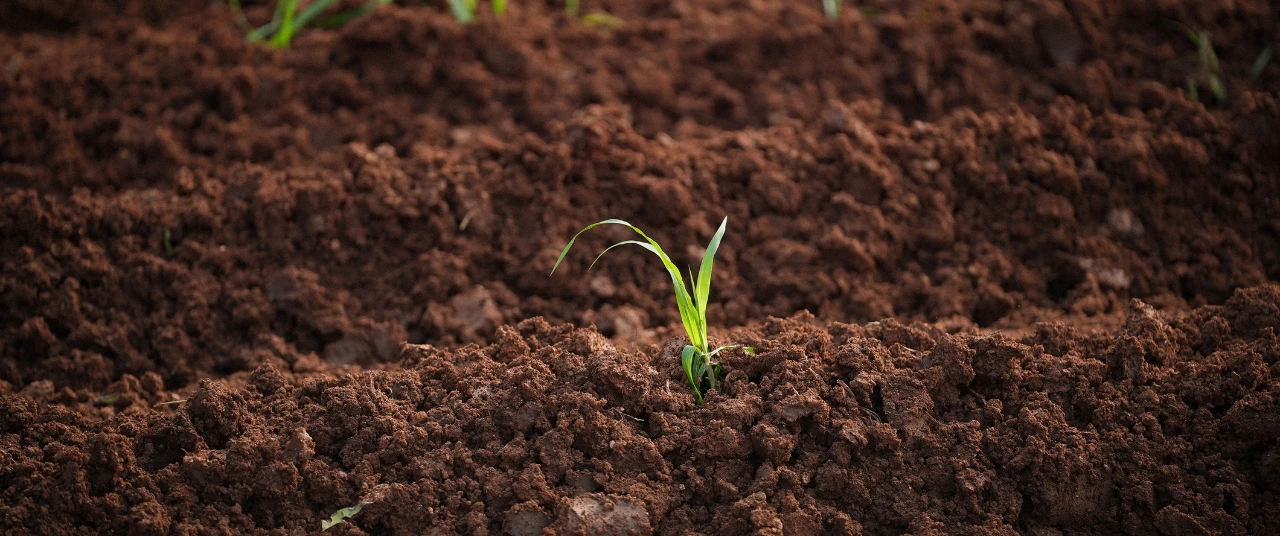
Syncing with the monsoon is important for a rain-fed crop like ragi; sowing too early or late has a direct effect on harvests
Editor's note: Even before its current status as a nutrient-rich superfood, ragi has been a crucial chapter in the history of Indian agriculture. Finger millet, as it is commonly known, has been a true friend of the farmer and consumer thanks to its climate resilience and ability to miraculously grow in unfavourable conditions. As we look towards an uncertain, possibly food-insecure future, the importance of ragi as a reliable crop cannot be understated. In this series, the Good Food Movement explains why the millet deserves space on our farms and dinner plates. Alongside an ongoing video documentation of what it takes to grow ragi, this series will delve into the related concerns of intercropping, cover crops and how ragi fares compared to other grains.
Every cropping season in India begins not with a seed, but with the sky. For generations, farmers have read the rhythms of the monsoon like a living calendar—each phase of rain marking a specific agricultural activity. In Karnataka’s dryland regions, this relationship between rain, soil, and crop choice forms the foundation of sustainable farming.
The Good Food Movement is growing ragi on a 2-acre plot in Tumakuru district’s Tiptur town using traditional, organic methods and documenting the entire process, from sowing cover crops, to choosing the right seeds, to planting, sowing and harvesting.
This article aims to provide an overview of the cropping conditions in Tiptur to understand what goes behind a successful ragi harvest cycle in these dryland landscapes.
Karnataka is divided into the more forested regions of Malnad in the West and the open lands of the Maidan in the East, each with its own land use and settlement culture. Agriculture is more commonly practised in the expanses of the Maidan. Tiptur sits in the South Maidan zone of Karnataka. This is a semi-arid region characterised by red-brown soils and undulating terrain. Tiptur’s landscape in particular is home to vivid red, loamy soils.
The region’s average annual rainfall ranges between 700-900 mm. Tiptur, being on the leeward side of the Western Ghats, is on the lower range of this rainfall spectrum, receiving about 680-720 mm. Most of this rainfall occurs during the southwest monsoon (June to September), which nourishes the Kharif crop cycle. Average temperatures stay between 24°C and 34°C across the year. These conditions make Tiptur ideal for millets like ragi, along with pulses and oilseeds that thrive in well-drained soils and intermittent rainfall.
Each phase guides what happens on the farm, from preparing the land and sowing cover crops, to mulching, and the final sowing of ragi.
In this landscape, rain is a planning tool. Farmers track the traditional nakshatra (constellation)-based rain calendar, using the names of constellations like Revathi, Ashwini, and Rohini to track rains throughout the year. In Kannada, Mungaru refers to the crucial southwest monsoon, while the Hingaru or northeast monsoon (October–December) supports Rabi crops. Each phase guides what happens on the farm, from preparing the land and sowing cover crops, to mulching, and the final sowing of ragi.
Also read: Why Akkadi Salu, an ancient practice of intercropping ragi, deserves a comeback
The cropping season begins around March-April, long before the main monsoon showers arrive. Farmers begin tilling and preparing their fields, before the first Revathi rains. This is followed by the sowing of cover crops—crops that are grown before the main crop to prevent soil erosion and replenish soil nutrients. Though there isn't a fixed rule for which crops to select, it is recommended to incorporate 80% as legumes for nitrogen fixation and 20% as non-legumes to maintain diversity. In our experiment, we used a mix of sunn hemp, spiny sesbania, horsegram, mustard, sesame and cowpea.
This stage, often overlooked in conventional agriculture, is crucial for restoring the land. The cover crops fix nitrogen, protect the topsoil from heat and erosion, and naturally add biomass once they are mixed back into the soil. As they mature, often growing 4–6 feet tall by the onset of the Mungaru rains in June, they create a dense green canopy which lowers soil temperatures, compared to land exposed to the sun.
The arrival of the southwest monsoons in June marks the onset of the Kharif crop cycle. The matured cover crops are tilled back into the soil using a rotavator in time for planting the main ragi crop. This produces green manure, a natural nutrient source that boosts soil fertility and microbial life. Around 16 tons of fresh biomass per acre can be generated in this phase, part of which contributes to long-term soil carbon.
Also read: A crop for the future: Why India should invest in ragi and its climate resilience
It’s important to sync the harvest cycle of ragi, a hardy millet and dietary staple in this region, with the Kharif monsoon cycle. Cover crops are sown to align with the onset of the first Ashwini rains. Thereafter, ragi is typically sown in late July—once the soil has absorbed sufficient monsoon moisture and the decomposed biomass. Farmers rely on consistent showers during the Pushya and Ashlesha (mid-July to mid-August) rains to aid germination. The Tumakuru district experiences the last of its rainfall in mid-October. By this time, the crop should have reached a healthy maturation rate of 70-80% so that it can be harvested in November. Syncing with the monsoon is especially important for a rain-fed crop like ragi: if you sow too early, harvesting might become difficult during heavy rains. Sow too late, and the soil may lose its moisture.
Rainfall patterns in Tiptur have become increasingly erratic over the last 5 years, in terms of both the number of rainy days and the quantum of rainfall received during a specific period. Delays during Mrigashira and Ardra (June and early July) mean that cover crops mature under limited moisture, forcing farmers to adapt dynamically—sometimes switching to short-duration millet or pulse varieties if rains fail to arrive on time.
This adaptive approach—watching the skies, responding to soil feedback, and making crop decisions in real-time—is the essence of rain-fed agriculture. Unlike irrigated systems, farmers here depend entirely on the sequencing of natural rainfall, balancing risk and regeneration.
This adaptive approach—watching the skies, responding to soil feedback, and making crop decisions in real-time—is the essence of rain-fed agriculture.
The red loamy soil of Tiptur is moderately low in organic carbon—which makes regenerative practices like cover cropping essential. Integrating organic manure and green biomass helps rebuild the soil’s structure, improving its ability to retain moisture and nutrients during dry spells.
By sequencing operations with each nakshatra calendar, farmers turn uncertainty into a working rhythm. Land is prepared and a layer of mixed cover crops is sown during the pre-summer rains. These grow into a canopy, and are re-incorporated into the soil during the early monsoon at the beginning of the Kharif season. Ragi is sown once the soil absorbs the biomass, and is then harvested when the spikes turn brown.
Agriculture is a dialogue between soil ecology and seasonal uncertainty. The Kharif cycle, too, isn’t merely a harvest calendar or a farming schedule. Each rainfall event, each temperature shift, reshapes the farmer’s decisions. Through cover cropping, green manuring, and careful timing, the land learns to breathe again between harvests.
Also read: The grain divide: How ragi and rice compare in the field and on our plates

Despite global health organisations and laws vouching for exclusive breastfeeding for the first six months, formula is making a dent in infant nutrition
Across delivery rooms in India, whether in public or private hospitals, newborns are increasingly being fed formula as their first meal, often without parental consent. This trend is not accidental. From the lack of institutional and infrastructural support for breastfeeding, to marketing by formula brands, to healthcare professionals advocating for formula milk (FM), infant formula is on the rise in India. This reality unfolds even as it poses deep threats to child health, maternal well-being, and inevitably, public nutrition.
A report from The News Minute details the experience of Vidya Sanap, a 32-year old researcher at IIT Bombay, who was eager to breastfeed after a C-section delivery, but when she asked the nursing staff for help, she was chided. “Your breast milk won’t run out if you don’t feed immediately,”—this is how Sanap remembers the nurses’ response. Another report in Quartz talks about another new mother’s first experience with breastfeeding: Sanika Chawla had delivered a healthy boy at a private hospital in Bengaluru. However, she didn’t get to hold him for several hours. Much to her chagrin, he had already been fed formula for his first meal.
These are just some among numerous examples in maternity wards, where babies are being whisked away by nursing staff and initiated on formula, against the mother’s wishes. What drives this breastfeeding-versus-formula turf war across Indian infant care?
The World Health Organization (WHO) recommends that infants be exclusively breastfed (EBF) for the first six months. Continued breastfeeding is recommended until a child turns two, with complementary foods being introduced after six months. Medical research has drawn countless links between early breastfeeding and its positive impact on both infant and maternal health. Lactation experts confirm that colostrum—the thick yellow liquid that is produced by the mother during pregnancy—is loaded with antibodies and immunoglobulins that boost infant immunity.
UNICEF advocates breastfeeding within the first hour of birth, but government data shows that only about 42% of all Indian babies have that healthy start.
Mothers also transmit good bacteria, which live in the infant’s gut, helping digest food and boosting their immune system. Breastfeeding significantly lowers infant mortality and risks of gastrointestinal disease and obesity in later life. Additionally, mothers who breastfeed have lowered chances of ovarian and breast cancer, Type 2 diabetes and cardiovascular disease. This is especially pertinent in countries like India with high rates of infant and neonatal mortality—27 infant deaths and 19 neonatal deaths for every 1000 live births in 2021.
UNICEF advocates breastfeeding within the first hour of birth, but government data shows that only about 42% of all Indian babies have that healthy start. There are legitimate reasons as to why breastfeeding isn’t always a viable option; not every newborn takes to the nipple immediately, or has a breastfeeding mother. Sometimes, new mothers also experience lactation failure.
The early makers of infant formula recognised this. The first known commercial infant formula was a cow milk-based formula made by chemist Justus von Liebig in Germany in 1865. Until then, many gave their infants other substitutes like homemade evaporated milk, and ‘pap’, a bread-and-water mush, from hard-to-clean utensils teeming with bacteria. Others employed wet nurses—women who were responsible for breastfeeding another’s child. Death rates were alarmingly high in the early 1800s, only two in three babies who weren't breastfed completed the age of one. The timing of Liebig's formula was opportune, and the appeal quickly spread beyond just women who couldn’t breastfeed. Liebig’s Soluble Food for babies (comprising primarily cow’s milk, wheat and malt flour and potassium bicarbonate) made commercial formula accessible and affordable.
Physicians in the 1960s and ‘70s (especially in the Global North) also began recommending these commercial formulas, making them more popular among mothers. However, an important detail to note here is that infant formula was developed as a substitute for breast milk, specifically for mothers who couldn’t breastfeed. Bridging a gap in infant nutrition was Liebig’s primary motive behind the development of formula.
And so it went, for a while: it seems like formula milk was mostly used on a case-by-case basis. What changed? What led to the formula boom?
Also read: The transformative potential of universal school meals
For one, the introduction of formula dramatically transformed the workplace. For many new mothers who want to, or must return to work, formula is a lifeline—especially when taking extended time away can come at a real cost to their careers. Several studies mention that earning gaps increase after mothers return to the workplace once their maternity leaves end. One mother says formula helped both her and her baby adapt to a work routine: “I had to go back to work in three months, so I started topping up with formula in two months so that my supply would temper and my baby would get used to the bottle.”
According to the WHO, the global formula milk industry was worth $55 billion in 2022. It has also found that global breastfeeding rates have increased very little in the last two decades. Meanwhile, the sale of formula milk has more than doubled in the same period.
Evolution has carefully fine-tuned the ‘recipe’ for breast milk to optimise for both maternal and infant health. Infant formula is a manufactured breast-milk substitute, available in liquid or powder form. However, infants' intestines are not naturally designed to digest these, lactation consultant Manisha Gogri says. Different compositions make up different infant formula. A series of articles published by The Lancet in 2016 lists the risks, which include more episodes of diarrhoea and respiratory infection. Companies that make formula claim that long chain polyunsaturated fatty acids in formula milk are involved in the development of the brain, eyes and the nervous system. However, these statements have little substantiation in scientific literature.
| Type of baby formula | Composition |
|---|---|
| Cow milk-based | The most commonly chosen formula. Made using cow milk, fortified with iron and lactose – compounds naturally found in breast milk. Butterfat is removed and replaced with more easily digestible fats |
| Goat-milk based | Contains proteins very similar to cow-milk based formulas, and also processed to the same nutritional standard |
| Soy-based | Contains a combination of protein and carbohydrates that differs from that found in milk-based baby formula. Usually recommended if babies are lactose-intolerant |
| Extensively hydrolysed | Also known as ‘predigested’ formula. Proteins are broken down into smaller components that make it easier for a baby’s system to digest. Babies prone to allergies or other health conditions benefit from this kind |
India has one of the most stringent laws in the world against breast milk substitutes, detailed in the Indian Milk Substitutes (IMS) Act, enacted in 1992 and enforced in 1993. The Act regulates the production, promotion, and distribution of infant milk substitutes by prohibiting advertising, point-of-sale promotions, and free samples, while placing stringent labeling requirements on these products as well. It also restricts health workers and institutions from providing biased information. Despite this, under the pretext of offering a substitute in cases of “low breast milk supply,” a multimillion-dollar industry thrives, claiming to calm crying or fussiness and to keep babies more satiated.
However, the idea of new mothers having a ‘low breast milk supply’ may very well be a myth. In a detailed report from The Wire, Dr. Arun Gupta, chairman of Breastfeeding Promotion Network of India (BPNI), a national NGO to promote healthy breastfeeding practices, says that a mother can usually produce enough milk to feed her baby, but it is often a challenge to bring the supply forth and nurse the baby. A host of other factors affect this process: milk production and flow depends—the more a baby breastfeeds, the greater the demand for milk in the mother’s body. Suckling activates nerves that signal the body to release prolactin and oxytocin. Prolactin triggers the alveoli to produce milk, while oxytocin makes the tiny muscles contract, pushing milk from the alveoli into the ducts. The release of oxytocin is also sensitive to a mother’s mental state. Dr. Gupta says that predatory tactics by formula makers disrupt this, pushing mothers into believing they cannot produce enough. Since breast milk supply is contingent on how much the baby feeds, introducing formula also affects it.
India has one of the most stringent laws in the world against breast milk substitutes, detailed in the Indian Milk Substitutes (IMS) Act
In India, especially, women face heightened familial and social scrutiny on their choice to nurse and/or introduce formula. A blog outlines how this new mother felt cloistered by her family while feeding: “Every session of breastfeeding (basically, every two hours) was slowly unravelling into a nightmare, where I felt I had no control. My female relatives would surround the bed, one of them holding the baby, and others pressing my nipple and commenting on my milk supply. My husband and I felt very helpless,” she says.
“I was under tremendous stress and … unable to generate enough milk for my son, who was subsequently fed only cow milk and formula,” another mother says. Surveys have found how over 50% of nursing mothers cite both physical and emotional breastfeeding woes, including sore nipples and irritated skin, a reason why they may turn to formula, especially if they have more than one child. These stories have themes in common: mothers feel like they do not have enough information and support on either breastfeeding or formula. This makes them feel like they have to endure the journey alone, and even when they do turn to formula, it isn’t without guilt or a public questioning of their scruples.
.jpg)
And then there is the matter of breastfeeding among low-income populations: one could expect it to be higher, owing to the rising costs of baby formula. What emerges is a very counterintuitive conclusion. The pressure to return to work makes EBF for six months difficult for many mothers, and this is especially true for the urban poor, who–being part of the informal labour sector–virtually have no maternal care benefits. There are examples of FM companies having infiltrated low-income countries as well: they offer cheap samples at first, and then dramatically increase prices, further entrenching families in cycles of poverty. Formula is also expensive, and so, many families tend to stretch out a box for much longer. The unavailability of clean water in most Indian slums, too, risks infant health.
Also read: Food fortification 101: Can foods built in with nutrients counter malnutrition, deficiencies?
If the IMS Act provides a solid legislative foundation, intervention by healthcare professionals is crucial to counter misinformation. Yet, the crisis is often exacerbated by the neonatal healthcare industry itself. A WHO survey on formula nutrition in 15 countries (excluding India) reported that 60% of women in Bangladesh and 45% in Nigeria had received a recommendation for formula from a qualified health worker. With birth rates declining in the West, countries like India and China have become primetime targets to boost formula sales. Another study across eight countries by the WHO and UNICEF—including Vietnam, China and Bangladesh—showed how formula marketing directly influences feeding decisions, despite the International Code of Marketing of Breast-milk Substitutes (1981). Apart from using a myriad of offline and digital marketing channels, formula companies also sought to alter medical professionals’ understanding of this breast milk substitute, since they had direct access to patients. Trusted brands have come under fire for promoting their products as ‘identical’ to breast milk.
Dr. Gogri says that one of the most common misconceptions that parents have about breast milk and formula is that they are equivalent in nutritional content.
Dr. Gogri says that one of the most common misconceptions that parents have about breast milk and formula is that they are equivalent in nutritional content. Dr. Armida Fernandez, former Head of Neonatology at LTGM Hospital, Sion (hereafter referred to as Sion Hospital), weighs in on how hospital staff are often complicit. “After birth, the baby should be put to the breast right away, because the more the baby sucks, the more milk will come in. In the first days, milk comes in very small quantities—sometimes just drops—and that is normal. Mothers need to be reassured that this is enough, since a newborn’s stomach is only about the size of a thumb,” Fernandez says. When the babies cry incessantly, parents panic and are led to formula as a quick-fix solution.
“Instead of keeping the baby on the mother’s chest and ensuring what we refer to as ‘skin-to-skin contact’, many hospitals put the newborn under a warmer and even give them a bath. Both these practices lead to rapid fluid loss,” Fernandez adds.
When asked about how formula is peddled in hospitals despite the IMS Act, Gogri underscores the basic fact that formula milk is, in the end, medicine. “Hospitals always stock FM containers, it is only advertising and promotion that is discouraged. Not all use of formula in hospitals can be attributed to malpractice or any malicious intent, really. More often than not, it's just a lack of awareness and negligible counselling about how important breastfeeding is in those early hours,” Gogri says. Many mothers aren’t aware of the benefits of breast milk, and even those who do, sometimes find themselves fighting back against their own caregivers.
Not all use of formula in hospitals can be attributed to malpractice or any malicious intent, really. More often than not, it's just a lack of awareness and negligible counselling about how important breastfeeding is in those early hours,” Gogri says.
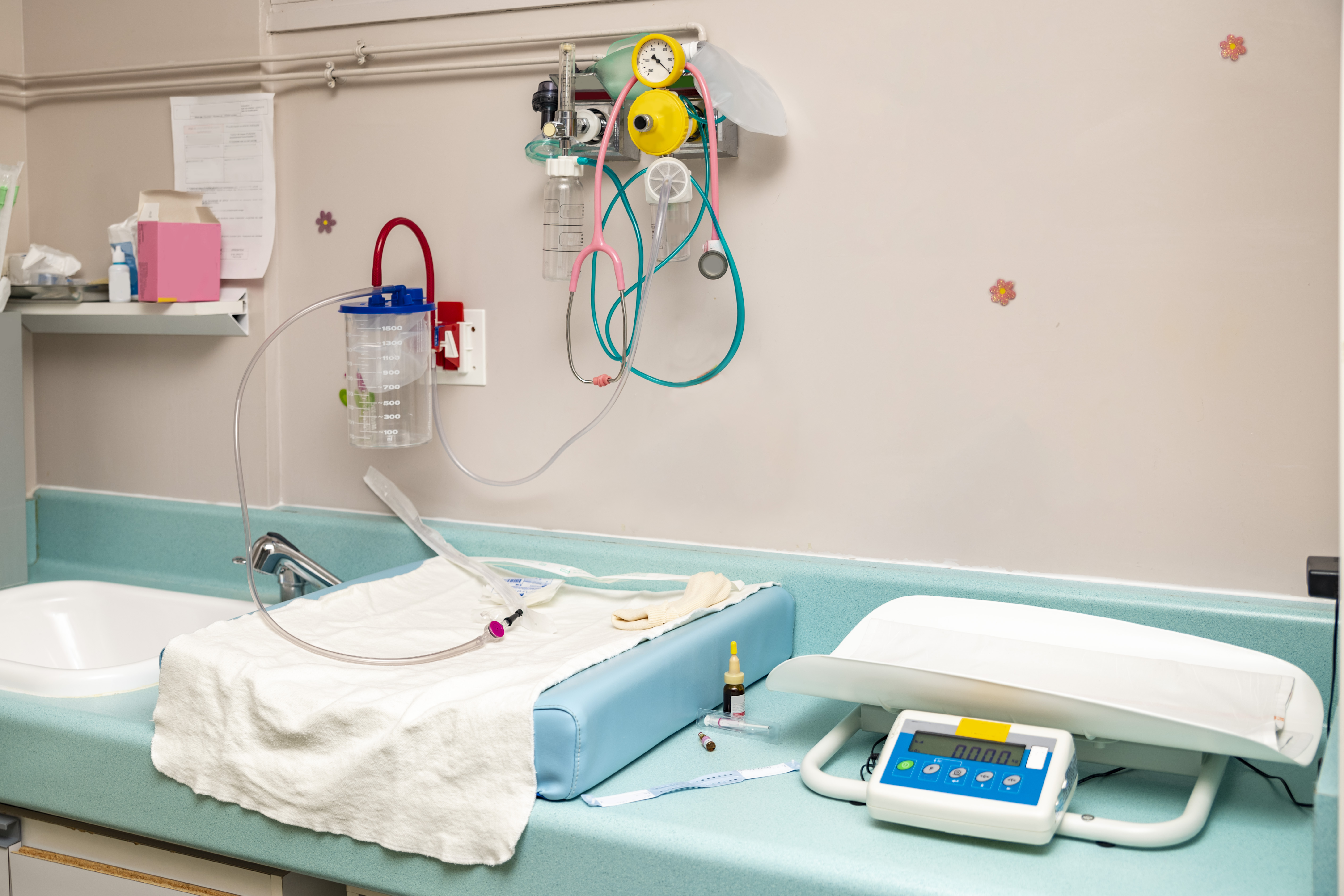
In India, a lack of infrastructural as well as social support for mothers also prevails. A dearth of breastfeeding and pumping rooms in public spaces and the stigma around breastfeeding in public in the first place also explains why mothers turn to formula. Gogri says that BPNI has set up Hirkani Kaksha–rooms designated for breastfeeding and expressing milk–in Maharashtra. “Several rooms have been set up at bus stops and train stations across Maharashtra. Unfortunately, many of them are unclean and in various states of disrepair; some have even become dumping grounds for trash,” she says.
Discouraging or banning formula milk is not the answer. Even the BPNI acknowledges that formula is an essential part of infant and young child feeding in cases of lactation failure. Brazil, which runs the world’s leading breast milk donation program, shows another path forward: one where mothers are encouraged to donate their milk to vulnerable infants who might otherwise depend on formula.
The need for human milk banks in India is immense. Each year, 2.7 crore children are born in the country, of which 75 lakhs have low birth weight and 35 lakh are preterm. A preterm infant requires at least 30 ml of milk—volumes that add up quickly across millions of births. Yet, infrastructure remains scarce: until 2013, only 8–10 milk banks existed, and even today metro cities average only 5–6 banks each.
Dr. Armida Fernandez pioneered Asia’s first milk bank at Mumbai’s Sion Hospital in 1989. When asked what the Sion Neonatal Intensive Care Unit (NICU) was like at that point, she says, “We were losing newborn babies because of diarrhoea and sepsis, and one of the reasons was a feed of formula. I realised that if we had to stop the infection at source, we had to move to breast milk exclusively. And to ensure a continuous and safe supply of human milk, we needed a human milk bank.”
At the time, the concept of milk banks was alien, and Fernandez faced a lot of distrust and suspicion. “I never faced skepticism from the mothers themselves. Many mothers were ill and needed milk to support their babies, and others in the ward volunteered to be informal wet nurses for strangers’ babies. Once, a new mother who was also a resident at the hospital fed a baby who had tetanus, and it survived only because of her,” she adds.
Himani Khandekar, the manager at the milk bank, or the Comprehensive Lactation Management Centre (CLMC) at Sion Hospital, Mumbai, says that the objective is to ensure that infants are exclusively breastfed until their discharge. The reality of operating a milk bank, however, is grim and laborious. “Our supervisors and counsellors are scattered across the NICU, TCU (transitional care unit), and the post-natal care units, where mothers and babies rest after discharge. All these areas have separate breast milk pumping stations. The staff make individual rounds, personally going from bed-to-bed, training mothers in better breastfeeding practices, helping infants to latch.,” Khandekar says.
All mothers who are admitted in the hospital undergo an evaluation of their medical history, a serological testing of their milk and a physical examination of the breasts. When patients pass this screening, they are encouraged to be donors. “Counsellors help mothers understand the benefits of donating: it relieves their fullness and pain, can help other vulnerable infants, and actually increase their production as well, quite contrary to the myth of ‘running out.’”
The milk from these three different areas is pooled and divided equally into three equal aliquots to be fed into the Sterifeed—a fully-automatic pasteurizer capable of holding 36 bottles of 250 cubic centimetres of milk. The milk undergoes a heating cycle, where it is heated to 62.5 degree celsius, and then rapidly cooled to 15 degrees and then 4 degrees over the next two hours. After this, it is meticulously labelled and stored in deep freeze storages of -20 C, and tested for bacterial contamination.
“We dispense the milk primarily to premature and extremely sick/vulnerable babies in the NICU, whose mothers are ill themselves, or are experiencing lactation failure,” Khandekar says. “People from outside have also approached us to access PDHM (Pasteurized Donor Human Milk) reserves, but unlike staff, they are unaware of the temperature it is to be stored at, or the window in which it should be consumed. This may end up causing more harm than good.” The reach of milk banks in India, therefore, remains starkly limited–especially when compared to countries like Brazil.
Shortage of PDHM is a persistent reality that milk banks face. “Not every mother admitted in our wards will be willing to donate her milk,” Khandekar says. For every donor who comes forward, there are several newborns in urgent need who go without. The bank operates with a small team, making this work demanding. Counsellors spend their days on their feet, moving endlessly between wards, balancing the urgency of persuasion with the labour of reassuring anxious mothers.
Dr. Fernandez says that milk banks in India face two major barriers: lack of institutional budgets for equipment and staff (most rely on private donations or Rotary support) and the limited number of donors beyond hospital mothers. Khandekar affirms that there is a massive gap in demand and supply. Unlike in other countries where lactation professionals follow up with milk collection at home, and a dense network is set up for supply, India relies mainly on in-hospital donations due to hygiene and storage constraints, severely limiting collections.
Also read: Sivaranjani Santosh's fight to knock mislabelled ORS off the shelf
Scaling up milk banks while promoting breastfeeding, while not a utopian, or fix-it-all solution, could be transformative. This approach eases the burden for mothers coping with delayed lactation, infant health issues, or bereaving the loss of their own child, while ensuring babies get safe nutrition—as opposed to the alternative, which is formula. Dr. Fernandez suggests setting up ‘milk donation camps,’ much like blood donation camps. This however, would require policy changes in budgeting and infrastructural support, and large-scale awareness of breast milk banks, when most of us might have never heard that they exist.
The dominance of formula milk in India is not as much to do with parental choice but the result of systemic neglect. Unless India invests in breastfeeding support and human milk banking, it risks outsourcing infant nutrition to commerce, where formula will continue to fill the gaps—at the cost of its youngest citizens.
Edited by Anushka Mukherjee and Neerja Deodhar
{{quiz}}
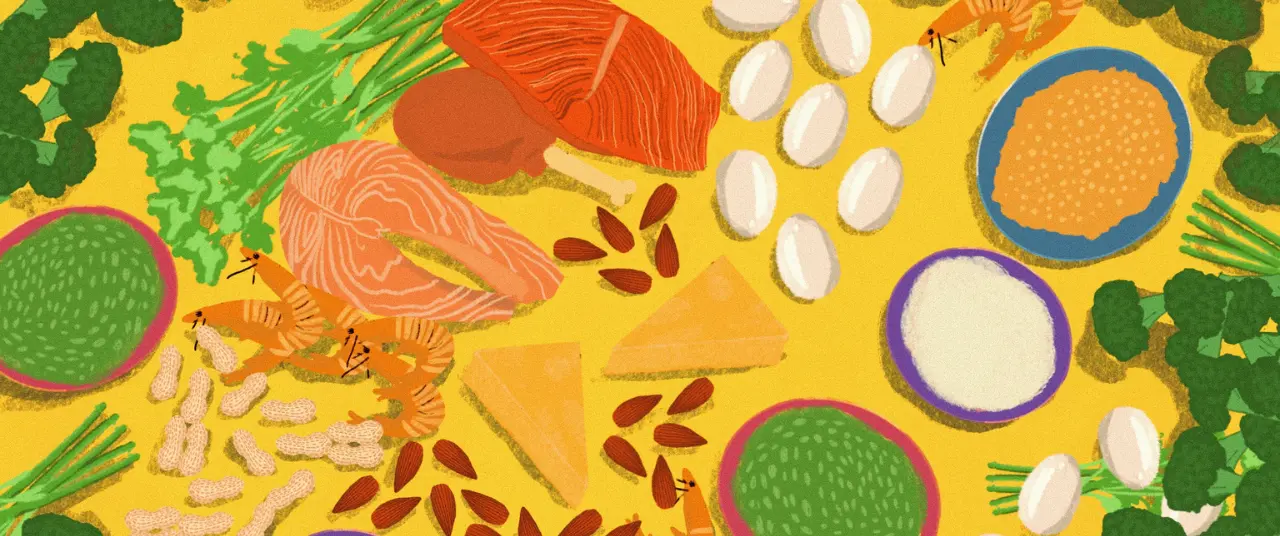
Spreading out your protein intake and timing it after workouts has the maximum benefit
Editor's Note: From grocery lists, to fitness priorities, and even healthy snacking, protein is everywhere—but do we truly understand it? In this series, the Good Food Movement breaks down the science behind this vital macronutrient and its value to the human body.
We often mistake the question ‘Are you getting enough protein?’ to be inquiring about the amount of protein-rich food we are eating. But this seemingly simple nutritional goal is also about ensuring that the protein gets used up by the body effectively. The World Health Organization has declared 0.8 g per kg of body weight as the minimum Recommended Daily Allowance (RDA). But the way this requirement is framed could be misleading—because adhering to this figure blindly does not guarantee that you can avoid deficiency.
Research suggests that having 0.4g per kg of body weight per meal across breakfast, lunch, and dinner actually increases the rate of muscle synthesis by 25% compared to when protein intake is skewed.
To begin with, we could look at a single plate of food. When you have more than a certain amount of protein in one meal, your body cannot digest it. If it were carbohydrates or fats that were in excess on the plate, the body would simply store them (as fat). But the body does not have a mechanism to store excess protein. Instead, any excess gets broken down first to ammonia, and then urea, before being discarded entirely.
Additionally, according to studies, we have a tendency to concentrate our daily protein intake around either lunch or dinner, leaving the other two meals of the day deficient. This means that the simplest and most crucial change you can make to your protein intake is to spread it out. Research suggests that having 0.4g per kg of body weight per meal across breakfast, lunch, and dinner actually increases the rate of muscle synthesis by 25% compared to when protein intake is skewed.
Also read: Is there an ‘ideal’ amount of protein that must be consumed?
This is believed to happen because of the specifics of a certain function of the body called Muscle Protein Synthesis or MPS. This is the process used by our muscle tissues to convert amino acid chains into muscle. MPS is relevant even if you are not an active gym-goer since our bodies have a daily muscle protein turnover. Every day, you lose some muscle mass, and you need protein to make new muscle mass to ensure that you maintain consistent muscle mass.
To stay on the lower end of the muscle loss scale, spreading out your protein intake should be your focus.
When we ingest high-quality protein, MPS begins, and slowly but surely, new muscle starts growing. But, MPS has a ceiling. The synthesis is in action only up to a certain amount of protein, and then it stops. This doesn’t mean the rest of the protein remains unabsorbed—it is certainly converted into amino acids and used by the body, just not for muscle building. Distributing protein intake throughout the day can, then, enable more opportunities for muscle building without hitting a ceiling.
This balance gets all the more crucial as you age. Sarcopenia is a fancy-sounding word for the gradual, progressive loss of muscle mass and strength that is linked with old age. Someone in their 30s may think old age is still some distance away, but alas, biologically, it has already sneaked in. You lose about 3-8% of your muscle mass every decade after hitting 30. This muscle loss makes you frailer, and can even increase the risk of fractures. To stay on the lower end of the muscle loss scale, spreading out your protein intake should be your focus.
Also read: Protein’s seen and unseen benefits: How it affects metabolism, muscle repair
Based on your health and lifestyle, other factors can help you adjust when to have protein, as well. For example, if you are looking to lose weight, then it might help to incorporate high-protein snacks like Greek yogurt instead of, say, biscuits, since they will keep you full for longer; this also ensures some of your protein intake happens outside of lunch and dinner. Remember, these high-protein snacks don’t have to be expensive; the quality of protein depends on its composition (does it have all essential amino acids?) and digestibility.
If you are someone who works out regularly, then incorporating protein during or right after your workouts is a good idea—it has been proven to reduce muscle soreness and fasten recovery.
If you are someone who works out regularly, then incorporating protein during or right after your workouts is a good idea—it has been proven to reduce muscle soreness and fasten recovery. If you are someone who rarely works out, you might find that exercise can help your protein goals. Any physical activity helps maintain muscle mass through a simple function. At any given moment, our muscles are being slowly broken down (muscle breakdown or catabolism) and being rebuilt again (muscle synthesis and anabolism), in the body. Muscle mass is maintained when the rate of muscle synthesis is higher than that of muscle breakdown—something that physical activity can ensure. Resistance and intensity training are the best ways to initiate anabolic or muscle building functions in the body. The muscle building benefits last for 24 to 48 hours post workout, and some studies have found that you could get the maximum benefits from consuming protein within two hours of your workout.
Also read: Why your body may not be optimising the protein you eat
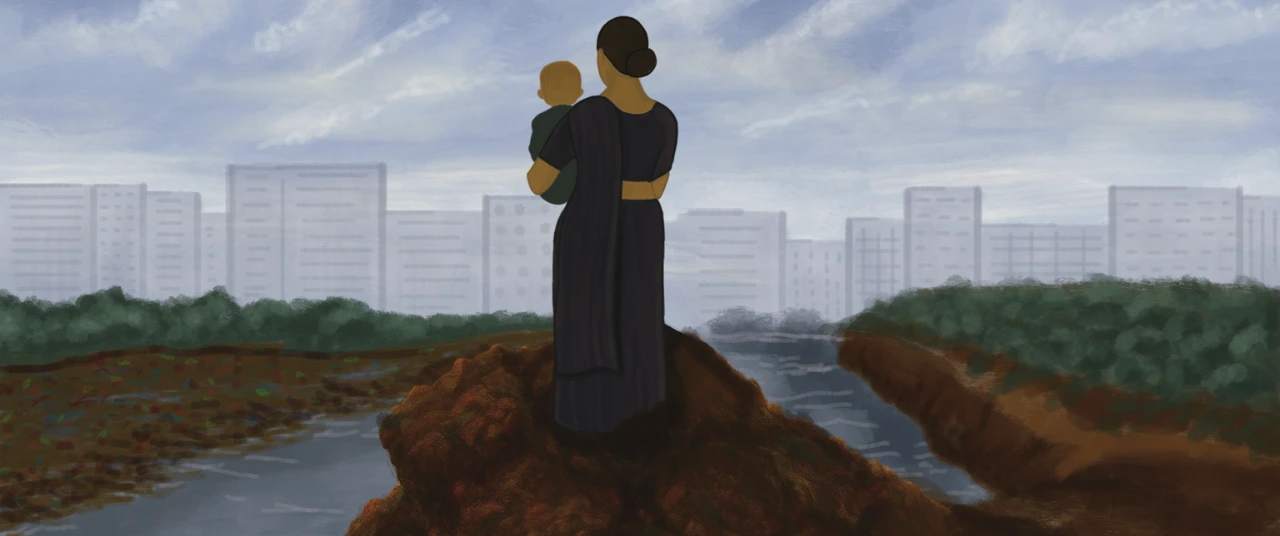
Infrastructural changes and everyday realities like the dumping of waste have made life inhospitable for the city’s poorest
Editor's Note: The last two decades have been witness to the rapid and devastating march of unchecked urbanisation and climate change in India’s cities. Among the first victims of this change is freshwater and access to it—from rivers which sustained local ecosystems, to lakes and groundwater which quenched the thirst of residents. In this series, the Good Food Movement examines the everyday realities of neglect and pollution. It documents the vanishing and revival of water bodies, and community action that made a difference.
On a bank of Mumbai’s Mithi—a serpentine, nearly 18 kilometre-long river—a group of children gather to play at Valmiki Nagar in the Bandra East suburb. One may imagine a childhood by a riverbank to be full of frolicking in its waters, but this is the harsh truth: the children of Valmiki Nagar spend most of their early years amid piles of garbage. A few years ago, a mound of waste near the bank was cleared, which has now become a playing area. Scattered across the ground are pieces of crumpled plastic, torn fabric, and broken debris—little dots splattered on the landscape on a risky, steep slope that drops sharply towards the river.
What can a river, neglected and polluted for decades, take away from human life?
The Mithi has two identities: at once, it is a rain-fed river as well as a stormwater drain.
The Mithi, whose name incidentally—and ironically—translates to “sweet” in Hindi, originates from the Vihar Lake outfall, and also receives water from the Powai Lake further downstream (its upstream catchment area has three lakes—Tulsi, Vihar and Powai). Across its stretch, it is not uncommon to spot people throwing garbage, small-scale vendors dumping scrap materials, and industrial units draining effluents into the river. The Mithi is also choked by untreated sewage and stormwater—and this is not just anecdotal of a particular neighbourhood it snakes through. According to the 2022-23 Water Quality Index, the river exhibits a concerning water quality status with an annual average WQI recorded as 35, indicating it is “Heavily Polluted”. A good, healthy river will have a WQI of at least 75, and excellent health will reflect in a score of above 90.
For over a decade, Talat Jahan, 40, has been residing at one of its banks in Sant Dnyaneshwar Nagar, opposite the Bandra-Kurla Complex (BKC) business hub. She has long given up on the idea of a better future for her neighbourhood. “Everytime my 17-year-old daughter comes back from her hostel, I send her across the river to our other flat as the living conditions here are intolerable for her. Residents get offended and argue with you if you ask them not to throw garbage into the river,” she shares.
Why are the residents along Mithi’s banks left to this fate? The answer is revealed in a series of events that led to this consistent neglect of the river as well as the dwellers living along its shores—only made worse by staggered development, massive embezzlement and an abject ignorance of the city’s topography.
From BKC to the slums of Dharavi, if one were to ask for directions to the Mithi river, they’d perhaps be greeted with puzzled stares and a curious question: “River? What river?” To the locals who have built a life alongside the river, the water body is known as a nallah, a word used to refer to a drain—usually a sewage drain. “Arre, wo toh nallah hai,” they will tell you.
“It is a river for all biological and scientific reasons, but in the Brihanmumbai Municipal Corporation’s (BMC) records, it is referred to as a stormwater drain. For the BMC, the river is a ‘Pavsali nallah’ in Marathi, which means ‘seasonal water drain’,” explains Stalin D., director of the NGO Vanashakti, a Mumbai-based environmental NGO that has been working to conserve mangroves, wetlands, rivers and coastal belts for nearly two decades now.
The Mithi has two identities: at once, it is a rain-fed river as well as a stormwater drain. Originally, it was only a river with water flowing solely in the monsoon season. It was a part of the city’s water supply chain, used as a transport system, and importantly, the estuarine region of the river fed and supported the local fishing communities. It was large, clean, deep. But it was in the way of a growing city.
In the late 18th century, when Mumbai was a collection of seven islands, a major land reclamation project began; under the East India Company, the erstwhile Bombay was to become one, joined city. Land was reclaimed from the water bodies flowing in and around the city, and all seven islands were united by roughly 1838. This put into motion a series of land reclamation projects that would, again and again, sew Mumbai’s lands together.
Alongside reclamation, encroachments—slums and unauthorised construction—significantly narrowed the river’s flow path, reducing its natural capacity to carry floodwaters and causing severe bottlenecks.
The Mithi river has always been important to Mumbai. It runs through some of the densest areas of the city, and is able to drain water from multiple suburbs like Powai, Andheri, Kurla, and Bandra when it rains. It also provides the most direct route to carry the excess runoff to the Arabian Sea, where it eventually drains off. And Mumbai’s particular topography, which affords it excessive rainfall in the monsoon season, presented the need to think carefully and urgently about flood planning. And so, as Mumbai underwent rapid urbanisation, the Mithi was “trained” as a stormwater drain.
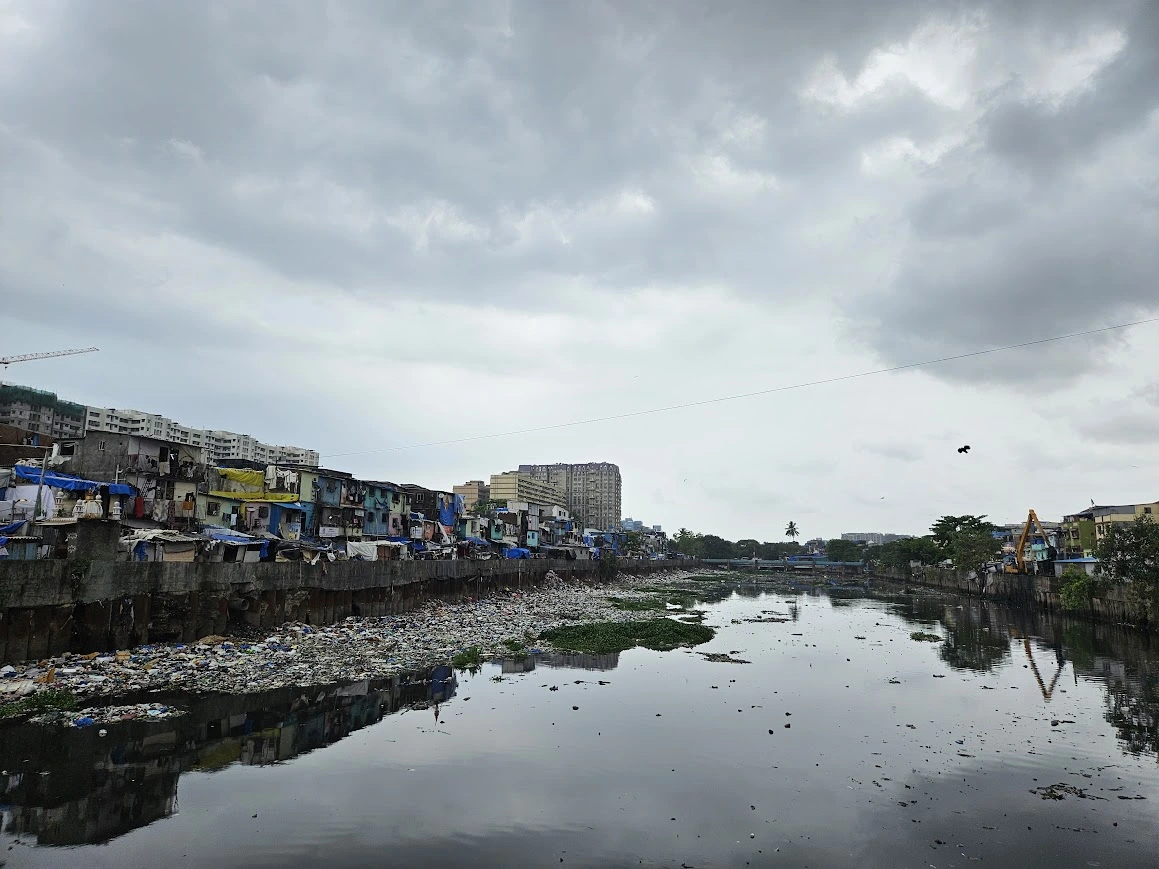
Large-scale land reclamation drastically reduced the river's original 800ha, as reported in 1930, to 400ha by 1973. In 1978, the Mumbai Metropolitan Regional Development Authority (MMRDA) reclaimed 370 hectares of land to create the Bandra Kurla Complex (BKC), of which 220 hectares were borrowed from the Mithi estuarine reach. Additionally, the construction of Mumbai’s International Airport and all related work from 1977 to 2004 also reclaimed swathes of land from the Mithi, destroying surrounding mudflats—essentially crumbling an entire ecosystem that traps toxins and houses biodiversity as well as nutrients crucial to the health of the river. The constant work at the airport forced the river to deviate unnaturally and rearranged its erstwhile linear flow.
Also read: The intertwined fate of Navi Mumbai’s Kolis and the Kasardi river
These infrastructural changes were not without consequence: Since Mumbai is an island city, several parts are at a low altitude above mean sea level (MSL). When high intensity rainfall coincides with high tide, flooding takes place in low-lying areas. That was the case of the sudden deluge on 26 July, 2005. The suburban part of the city experienced unprecedented, heavy showers with a record of 944 mm of rainfall in 24 hours—and the highest rainfall intensity of 190.3 mm in one hour between 15.30 pm to 16.30 pm. This coincided with the highest tide of 4.48 m.
The Mithi—choked, thinned and heavy—extracted its revenge by throwing up caught rainwater into the city, leading to a devastating flood in a form that was much worse than it otherwise could have been.
Alongside reclamation, encroachments—slums and unauthorised construction—significantly narrowed the river’s flow path, reducing its natural capacity to carry floodwaters and causing severe bottlenecks. “The river’s training was not really focused on the river itself, but on creating assets, with what remained taking the shape of the river,” says urbanist Gautam Kirtane.

Presently, as the water from the Vihar lake flows down, it passes through Filterpada, a notified slum and the first immediate settlement on the river. Zoya, a 10-year-old who lives in Filterpada, shares that she battles swarms of mosquitoes every night, relying on repellants like coils.
When the water from both the Vihar and Powai merges, the river threads through the neighbourhoods of Morarji Nagar and Jai Bhim Nagar in Powai. As one steps down from the main road to enter into the slums of Jai Bhim Nagar, the river emerges as an open-mouthed dumping site for household waste. In the area, a visibly gigantic freshwater pipeline passes over the river, through the two localities. This risky pipeline is often used by children and adults to walk over and cross the river in a hurry.
Ahsan Akhtar Sayyed, over 70 years old, has lived in Powai's Jai Bhim Nagar for over two decades. He is also the president of the Aadarsh Rahiwashi Welfare Committee, a group formed to resolve the issues of Mumbaikars living in the area. “Earlier, though the water was polluted, as it included wastewater from households and the runoff from cleaning filter tanks, the Mithi was never stagnant. Today, aside from the monsoon season, the river is inert, which leads to waste getting accumulated and rotting for several months—sometimes years,” says Sayyed. In this neighbourhood, the river is covered with blankets of hyacinth and other waste.
A few months before every monsoon, a strange routine unfolds: a bulldozer collects the waste rotting in the river.
Barring one placed in front of Sayyed’s house, there are no dustbins in the riverfront lane. Neither is there any door-to-door collection of waste here, Sayyed informs; even this lone bin was provided by the current MLA of Andheri East, Murji Patel. Residents are asked to dispose of garbage in one dumpster kept at a distance; with access so curbed, residents are left with no choice. As a result, an unbearably foul smell emanates from the bank.
“Yeh garib basti hai (This is a slum),” says Sayyed, “People here leave early in the morning and return home late, after work. It is difficult for them to worry about environmental issues when they are finding it difficult to make ends meet.”
A few months before every monsoon, a strange routine unfolds: a bulldozer collects the waste rotting in the river, Sayyed shares. “But since a dumping truck can’t enter inside the narrow lanes of this neighbourhood, the garbage is levelled back into the river.” Stalin throws light on this inexplicable phenomenon: the waste is levelled inside the river when heavy rains are expected so that it can be carried further downstream as the river flows. The waste then gets collected in the mangrove near the BKC estuary area, polluting the ecosystem heavily.
Notably, the Mithi has been consistently included in Priority I of Mumbai’s polluted river stretches, primarily due to Biochemical Oxygen Demand (BOD) values exceeding 30 mg/l. The average BOD of Mithi in 2022-23 was 37.3 mg/l, and the maximum was 82 mg/l.
Retaining walls are constructed along riverbanks to secure the edges between two ground surfaces of different elevations. However, in the case of Mithi river, these were constructed to train the river’s course for flood control, after the 2005 floods. Jal Biradari, a community dedicated to the protection and revival of rivers, and the Vanashakti NGO challenged the Coastal Regulation Zone (CRZ) clearance granted for constructing retaining walls, which impeded water flow to mangroves. In May 2016, the National Green Tribunal imposed a Rs 25 lakh fine on the MMRDA as environmental compensation for violating CRZ norms by constructing retaining walls.
“Years ago, in 1995, this place felt like our village. The river was dirty and had waste dumped on the sides, but it was visibly clean in the centre. There were no retaining walls and the water was 15-20 feet deep. People would bathe in it and wash their clothes at the banks,” Sayyed says, recalling the “acche din” of the river’s past.
Also read: The Chitlapakkam Rising story: How a Chennai community saved a lake
For Sant Dnyaneshwar Nagar’s residents in BKC, it is a nightmare to bear the consequences of all these years of neglect. One is greeted by heaps of solid waste on the entrance road of this area; not only can you find residents and shopkeepers throwing waste nonchalantly into the river, but also children competing against each other–aiming for the farthest shot. The river is heavily contaminated with plastic bags, scrap materials, food waste, metal, alcohol bottles and thermocol waste. You may even happen upon an unbearable sight for any nature lover: birds like sparrows, crows and egrets searching through waste to find food for themselves.
As is the case in Powai’s Jai Bhim Nagar, there is no dumpster in sight at the riverfront lane. In fact, in the low-lying area of Valmiki Nagar, it won’t be surprising to find an empty dustbin afloat at the bank’s edge, surrounded by trash.
"Previously, we tried to install dustbins in Sant Dnyaneshwar Nagar, but delinquents either burnt them or sold them to scrap dealers for quick cash," says Lubna Shaikh, a social worker. During the scorching heat of the summer, locals have no option but to take calculated breaths amid the stench of rotting waste that persists for months, even years, as water in the river remains stagnant. “This is a densely populated area where malaria, dengue and typhoid are some of the most common diseases,” Shaikh adds.
Talat Jahan, who has a family of five and runs a paan shop, says, “Earlier, I used to confront people, but now I have resigned and accepted that I will have to live in this condition. I don’t have time to get into fights or arguments—I have a family to run and look out for. People in the neighbourhood have accepted this lifestyle.” She has a rental stay near Kalyan on the outskirts of Mumbai where a door-to-door garbage collection service can be opted for. But owing to her livelihood and her husband’s illness, she is bound to reside in Sant Dnyaneshwar Nagar. Mumbaikars like her question the unfairness of living in a city where one neighbourhood has access to garbage collection services, but the other is entirely deprived of them.
During the scorching heat of the summer, locals have no option but to take calculated breaths amid the stench of rotting waste that persists for months, even years, as water in the river remains stagnant.
The typical pre-monsoon sight of an excavator crane in Bharat Nagar removing the waste and hyacinth from the river—leaving a trail of charcoal-coloured leachate behind on the road—is a stark reminder of how year-long neglect takes a physical form. This year, as of June, this waste collection drive was not undertaken.

The nearby neighbourhoods of Maharashtra Nagar and Valmiki Nagar (across the river) bear the brunt of Mumbai’s heavy rainfall. “The residents have to pay a heavy price as there is an absence of retaining walls in these regions since 2017, when exceptionally strong rainfall led to collapse of the previous wall,” shares Shaikh.
The retaining walls serve more than one purpose. Urbanist Gautam Kirtane sheds light on a sociological phenomenon—“splintering urbanism”—that emerges from geographical division: about how the city's local train lines shape its wealth brackets. For example, the areas to the west of the Western Line include suburbs like Bandra, Santacruz, and Khar that are far more affluent than the eastern side of the same line: Dharavi, Bandra East, and Kurla.
Such a pattern can also be observed along the course of the Mithi river. "The Mithi is the most in-your-face example of the distinction between slum and non-slum areas. It actually divides the city into administrative divisions. All that is on the east of the river are the eastern suburbs and on the west, the western suburbs. Much of the administrative boundary is also defined by this wealth differentiation. So, from a sociological perspective, these retaining walls are the great wall of Mumbai," says Kirtane.
The urbanist has observed a difference in waste management policies for slums and non-slums in Mumbai. “In the slums, a project called the Swachh Mumbai Prabodhan Abhiyan (SMPA) is conducted on a voluntary basis. But ideally, waste collection is supposed to be a mandatory function of urban local bodies,” he explains, arguing that this unequal treatment stems from the city's perception of slums. “There's a classist and casteist undertone to this reality,” he explains.
While residents have adapted to the river’s polluted state, their survival costs them multifold—in health, safety, and dignity. The authorities’ piecemeal efforts across desilting, retaining walls, and offering unfulfilled promises have failed to address the root causes of the river’s degradation. “The Mithi comes under the storm water management department of the BMC. Stormwater is meant to carry only rainwater, the garbage in the rainwater is to be removed by the solid waste department. The solid waste department puts its hands up when tasked with removing waste from the storm water area,” says Stalin, underscoring how the responsibility of ensuring their well-being, safety and health falls squarely on the shoulders of riverbank residents, abandoned by city authorities and urban planners.
Also read: In Gurugram’s rise, a cautionary tale about satellite cities and groundwater
Edited by Neerja Deodhar and Anushka Mukherjee
Illustration by: Khyati K
Produced by Nevin Thomas and Neerja Deodhar
{{quiz}}

The interaction of millets like sorghum with trees like teak creates the holistic ecosystem needed for the Earth
Editor's note: Even before its current status as a nutrient-rich superfood, ragi has been a crucial chapter in the history of Indian agriculture. Finger millet, as it is commonly known, has been a true friend of the farmer and consumer thanks to its climate resilience and ability to miraculously grow in unfavourable conditions. As we look towards an uncertain, possibly food-insecure future, the importance of ragi as a reliable crop cannot be understated. In this series, the Good Food Movement explains why the millet deserves space on our farms and dinner plates. Alongside an ongoing video documentation of what it takes to grow ragi, this series will delve into the related concerns of intercropping, cover crops and how ragi fares compared to other grains.
Forests and farms have an ancient link: centuries ago, the first farms were carved out of forests. Humans evolved from farming within the forest, to farming alongside it. We planted woody trees into farmlands and held onto the forest, even as agricultural land expanded.
However, over time, as the two became more distinct, so did their functions. The forest became the custodian of biodiversity and the farm the provider of food: two diverging arms that could not meet. In the mid-1970s, as scientists sought to bring back the practice of farming alongside forests, John Bene, a Canadian forester published a study coining the term agroforestry.
Agroforestry, as the name suggests, is an integration of woody vegetation (trees or shrubs) with farmlands and animal husbandry. However, it is more than just the introduction of trees into farms—it is the dynamic interaction of all three elements (farms, animals, and trees) to create a more diverse ecosystem. And while proponents usually frame it as a method of land management to be introduced into farms, it has also traditionally included farming within forest lands by indigenous communities. Just like intercropping diversifies from the main crop by planting subsidiary crops, this technique incorporates trees and shrubs into the ecosystem of the farm and enriches it. Neem trees serving as wind barriers for a bajra crop, jackfruits harvested within forest lands, or coffee plantations growing in the shade of mango trees are all examples of agroforestry in practice.
Also read: Why Akkadi Salu, an ancient practice of intercropping deserves a comeback
As a farming system, agroforestry is both farmer- and climate-friendly. In many ways, it is analogous to organic farming. The mulch the trees provide replaces fertilisers, and the friendly predators they house – like birds and insects – feed on pests, replacing pesticides. Agroforestry is also believed to have a higher potential for carbon sequestration than single-species farms.
Agroforestry is also believed to have a higher potential for carbon sequestration than single-species farms.
Trees anchor a farm and enrich the soil—from preserving the top soil and preventing soil erosion, to serving as mulch and negating the need for fertilisers. Their cooling effect on fields increases yield. Beyond enhancing the main crop’s yield, fruit trees can serve as an additional source of income, becoming a useful safeguard during lean harvests. Similarly, they can bring diversity to the local wildlife and animal feed while also reducing methane emissions associated with livestock farming.
Also read: The grain divide: How ragi and rice compare in the field and on our plates
Indigenous communities, worldwide and in India, have been practicing agroforestry since time immemorial. But it was only in 1983 that research in agroforestry got consolidated government support in India. In February 2014, India became the first country to adopt a National Agroforestry Policy, which included easing rules on harvest and transit of agroforestry products and providing a range of financing options for farmers.
In recent years, millets have found renewed interest in agricultural spaces because they are climate resilient. Given that they also have more proteins and minerals than cereals like wheat and rice, they are gaining consumer appeal. And they continue to be culturally relevant in several arid and semi-arid parts of the country, with India making up 80% of all millet production in Asia, and 37.5% of global production.
In February 2014, India became the first country to adopt a National Agroforestry Policy, which included easing rules on harvest and transit of agroforestry products and providing a range of financing options for farmers.
This makes millet-based agroforestry a uniquely positioned climate solution. Ragi, with its significance across the country, and especially in the Deccan Plateau, becomes a key grain to consider in this context.
Across India, ragi is frequently intercropped with trees for a variety of benefits. In Karnataka, Andhra Pradesh, and Telangana, ragi is usually accompanied by the maha neem (melia dubia). In Karnataka, it is also common to intercrop with Gliricidia sepium, which increases the microbial biomass. Fruit trees like jamun, mango, and guava are often incorporated, as are root vegetables like carrots and beetroots. Ragi is also often rotated with maize in Karnataka.

Bhimal (Grewia oppositifolia) is often planted alongside ragi in Uttarakhand. In Maharashtra, ragi grows under the shade of the bamboo. Other millets have also been successfully incorporated in agroforestry. Sorghum is commonly planted with teak. Pearl millet planted in Rajasthan under Indian jujube was wildly successful, while in Uttarakhand it has grown well under poplar too.
In many ways, agroforestry is the harvesting of sunlight in layers.
For these benefits to truly accrue, the combination of trees and crops have to be chosen carefully to complement each other—their heights and root systems upon maturation should maximise the reach of sunlight and soil moisture. In many ways, agroforestry is the harvesting of sunlight in layers. For instance, let us take the example of an agri-horti-forestry system. The crops are layered, with the first layer being a ground layer crop like a tuber. The second layer includes crops that will reach 2-3 feet height, like ragi. The third layer is usually horticultural plants like jackfruits or papaya which grow 10–15 feet high. The fourth (and usually final) layer includes plants growing beyond 15 feet, mostly including tree crops like bamboos which serve as wind barriers, but can also be harvested for additional income.
Across the world, millet-based agroforestry has existed, not only because it makes farming more holistic and profitable, but because it contributes important ecosystem services and mitigates the environmental impact of intensive farming. India is in a unique position to revive these traditional agroforestry systems—land, yields, farmers and the planet all stand to gain much from it.
Also read: Rewilding farmland: The story of Shihab Kunhahammed’s edible forests
{{quiz}}

India falls short on protein and could do better with whole grains. Its ghee consumption raises concerns
The Plate and the Planet is a monthly column by Dr. Madhura Rao, a food systems researcher and science communicator, exploring the connection between the food on our plates and the future of our planet.
On October 2, 2025, the EAT-Lancet Commission, a global consortium of 70 scientists from 35 countries working at the intersection of nutrition, health, and sustainability, released an updated version of its landmark 2019 report, which first introduced the idea of a Planetary Health Diet (PHD). Like many food systems researchers around the world, I have been busy parsing the report and assessing how its updated evidence base reframes global discussions on sustainable and healthy diets. For anyone who has read the 76-page report and its supplements, its scale and scope are immediately evident. It brings together an extraordinary range of evidence across disciplines, leaving much to be discussed.
In this column, however, I focus on the PHD and explore how the average Indian diet stacks up against its vision for healthy and sustainable eating. The PHD is framed as an optimal diet for improving the wellbeing of the global population and has been developed based on the health impacts of consuming various foods. However, the report provides evidence indicating that the widespread adoption of such a diet can reduce the negative environmental impacts associated with most current diets, making it a means to improve the health of people as well as the planet.
By no means are my observations a report card of the Indian diet, for it remains unclear whether the PHD is entirely suitable for the developing country context (more on that in the last section), but rather an attempt to understand where India’s eating patterns stand in relation to its principles.
The 2025 PHD serves as a global reference framework that must be adapted to local cuisines and food systems, as well as to individual characteristics such as age, sex, body size, physical activity level, pregnancy and lactation status, health condition, and genetics. The diet, based on a 2400 kcal energy intake per day, recommends consuming generous quantities of plant-based foods like fruits and vegetables, moderate amounts of animal-sourced foods, and minimal quantities of ultra-processed foods, added sugar, saturated and trans fats, and salt. Here’s what it recommends per food group:
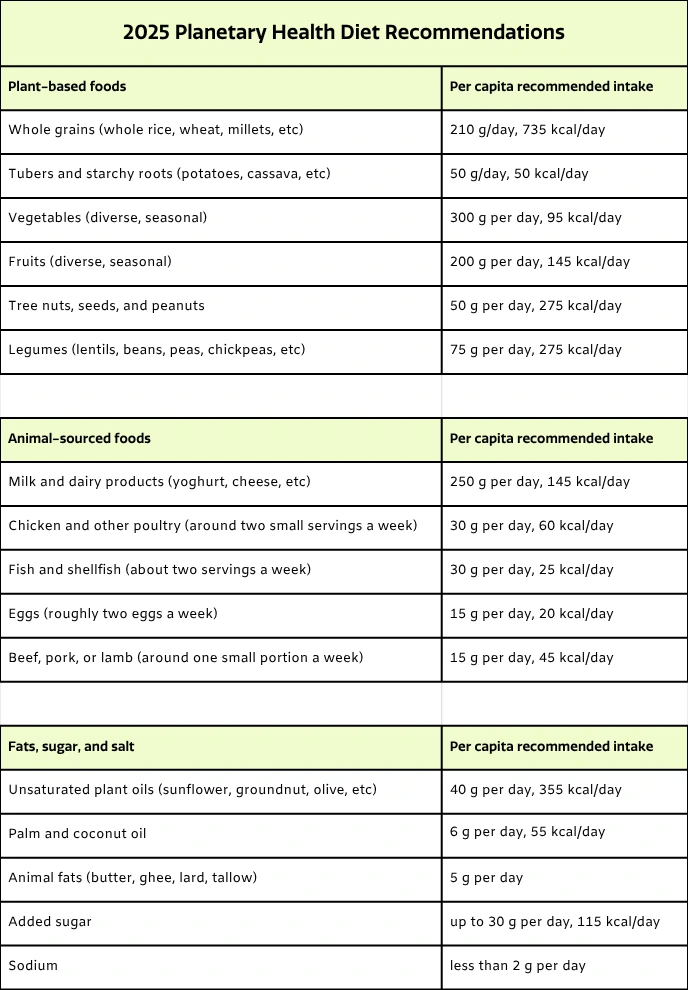
The EAT-Lancet report compares its recommended diet with average dietary patterns across different world regions. India is grouped within the South Asia region, and while country-level comparisons for the 2025 report are not yet available, regional averages offer a useful reference point. Let’s take a look for each macronutrient category.
Carbohydrates form the foundation of most diets, and within the PHD framework, whole grains, tubers, fruits, vegetables, and sugar are the key components to consider. Global whole grain intake is far below recommended levels. South Asia fares better than all other regions of the world (rotis to the rescue!) but still only meets half the target. This does not mean grains are lacking in Indian diets; rather, they are mostly consumed as refined products such as maida and polished white rice. Recent research by the Indian Council of Medical Research shows that Indian adults derive roughly 62% of total energy from low-quality carbohydrates, largely refined cereals and added sugars. The same study shows that high carbohydrate intake is associated with a higher likelihood of non-communicable diseases such as Type 2 diabetes, obesity, and cardiovascular diseases within the population. In many low- and middle-income countries, whole grain foods are less available and more expensive, partly because the nutrient-rich bran and germ are removed and sold as animal feed.

Tuber consumption in South Asia roughly aligns with the PHD recommendation, though our fondness for potatoes shows through as the average slightly exceeds the suggested limit. Sugar intake surpasses the suggested level by about 25% but remains well below that of regions such as Latin America and the Caribbean and North America. Fruit and vegetable intake in the region remains below recommended levels, with vegetables faring better than fruits, for which South Asia records the lowest consumption among all regions.
Let’s turn to protein. Consumption trends for plant-based foods such as nuts and legumes, and animal-sourced foods like milk, poultry, eggs, fish, and red meat, tell an interesting story. Globally, average intakes of nuts, seeds, and legumes fall well below the levels recommended by the PHD. South Asia performs relatively better, ranking second only to Sub-Saharan Africa in legume consumption. But even here, the average intake is only about half of what the PHD suggests, even though lentils and pulses feature so prominently in the region’s culinary traditions.
While reducing excessive meat intake is crucial in many parts of the world like North America, Latin America and the Caribbean, and Europe and Central Asia, in India the challenge is the opposite: ensuring that people consume enough high-quality protein from both plant and sustainable animal sources to meet their nutritional needs.
For animal-sourced foods, South Asia’s averages are similarly below the recommended levels: eggs at roughly 75%, fish and milk around 50%, red meat about 50%, and poultry between 15 and 20% of the PHD targets. Among all regions, South Asia shows the lowest levels of poultry, fish, and red meat consumption. Earlier research comparing the 2019 PHD with Indian dietary patterns found consistently low caloric intake from protein sources, both plant- and animal-based, across all regions, sectors, and income groups. The deficit was most pronounced in rural areas, where only about 6% of total calories came from protein, compared with 29% in the 2019 reference diet.
At first glance, the region’s relatively low consumption of animal-sourced foods might appear environmentally beneficial, especially when compared with the high levels typical of North America, Europe, and parts of Latin America and even Sub-Saharan Africa. However, this gap also points to a serious protein inadequacy in South Asian diets. While reducing excessive meat intake is crucial in many parts of the world like North America, Latin America and the Caribbean, and Europe and Central Asia, in India the challenge is the opposite: ensuring that people consume enough high-quality protein from both plant and sustainable animal sources to meet their nutritional needs.
Also read: Ultra-processed foods are reshaping our diets. Should we be worried?
When it comes to fats, South Asia shows an interesting mix of alignment and excess. Vegetable oil consumption is close to 40% of the amount recommended by the PHD. Most other regions fall short of this benchmark, with only North America and Europe and Central Asia slightly exceeding it. Palm oil consumption in South Asia is around 70% of the recommended level, a more moderate figure than in regions such as Sub-Saharan Africa or East Asia and the Pacific, where it is considerably higher. Palm oil is not traditionally part of South Asian diets, but its low cost and long shelf life have made it a preferred ingredient in the food processing industry.
This does not mean grains are lacking in Indian diets; rather, they are mostly consumed as refined products such as maida and polished white rice.
Animal fat consumption, on the other hand, tells a different story. At roughly 60% more than PHD’s recommended amount, it is the only food group in which South Asia significantly exceeds the recommended level. This likely reflects the region’s enduring fondness for ghee and other dairy fats, both in home cooking and festive cuisine. While these fats hold cultural and culinary importance, their high saturated fat content raises concerns for cardiovascular health, particularly as diets become more energy-dense and lifestyles more sedentary.

The EAT-Lancet commission strongly urges public authorities to adapt the principles of the PHD to local nutritional needs and cultural preferences via national dietary guidelines. In the Indian context, the National Institute of Nutrition’s (NIN) dietary guidelines are interesting to consider in this regard. Released in 2024, the guidelines do not make any reference to the PHD. However, both guidelines present many overlaps. Since the PhD is based on a 2400 kcal intake and the NIN’s guidelines on a 2000 kcal one, it is not possible to compare recommended quantities for various foods directly. However, both propose a diet that is rich in vegetables and pulses and moderate when it comes to animal-based foods, fats, and sugar.
Some differences between the PHD and NIN guidelines are worth discussing here as well.
Some differences between the PHD and NIN guidelines are worth discussing here as well. For instance, while the PHD allows about two eggs per week, the NIN recommends one egg a day. It also recommends fruits in much lower quantities than the PHD. These differences reflect India’s specific nutritional deficiencies, affordability concerns, and access issues. But some other differences might hint at blind spots. For example, the NIN guidelines group oils and fats together with nuts, without clearly distinguishing between animal-sourced or saturated fats and healthier plant-based options. Such an approach risks overlooking the excessive consumption of animal-sourced fats, which the EAT-Lancet report identifies as a dietary concern in South Asia. The NIN also classifies tubers like potatoes under vegetables, whereas the PHD treats them as a separate category with a limited share of the diet.
Also read: What it takes to feed India’s growing cities
The 2019 EAT-Lancet report was criticised for proposing a diet that was out of reach for much of the developing world. A 2020 study found that the cost of an EAT–Lancet diet, even when adapted to local contexts, exceeded household per capita income for at least 1.58 billion people. The recommendations of the 2025 report do not deviate much from the 2019 ones (though they do come with stronger evidence) even as consuming fruits, vegetables, nuts, and even meat in quantities suggested by the PHD remains unattainable for people in most developing countries including India.
All in all, while it might be unrealistic to expect the Indian population to consume 500 g of fruits and vegetables and 50 g of nuts and seeds every day, there are areas where policy action can make a meaningful difference.
Affordability is only one part of the picture. The report also draws attention to a stark imbalance in responsibility: the wealthiest 30% of the global population account for over 70% of food-related environmental impacts, and diets in regions such as North America and Europe have a far greater environmental footprint than those in South Asia. This contrast raises an important question—should a country like India be expected to change its diet when it contributes far less to global environmental degradation? I believe the answer is still yes, not for environmental reasons alone, but because the framework speaks directly to urgent public health needs.
There is much that the government can do with the analysis presented by the report. To begin with, understanding how India eats requires better evidence. Research that compared the Indian diet with the first EAT-Lancet’s PHD relied on national consumption data from 2011–12, the last comprehensive survey of its kind. National level data from 2018–19, which could have provided an updated picture, could not be used because of quality concerns. Without new data, policy design risks being reactive and fragmented.
The widening gap between those who can afford diverse, nutrient-rich foods and those who cannot is also an area that must be addressed by the government. Urban and higher-income populations have greater access to diverse and nutrient-rich foods, while rural and poorer households remain dependent on cereal-heavy diets. Food price volatility, insufficient government aid, and uneven social and economic development across regions have deepened these divides.

All in all, while it might be unrealistic to expect the Indian population to consume 500 g of fruits and vegetables and 50 g of nuts and seeds every day, there are areas where policy action can make a meaningful difference. Expanding subsidies and procurement support for whole grains, pulses, and fresh produce, alongside public campaigns to reduce sugar and animal fat consumption, would help shift diets in a healthier direction and curb the incidence of non-communicable diseases. Strengthening the Mid Day meal programme and public distribution schemes to prioritise nutrient-rich foods could also help bridge dietary gaps without placing additional burdens on households. Steps such as these should be taken in order to strengthen nutritional security and the resilience of India’s food system in the face of environmental and economic pressures. Because, after all, the wellbeing of one-sixth of humanity cannot be separated from the wellbeing of the planet itself.
Artwork by Alia Sinha
{{quiz}}
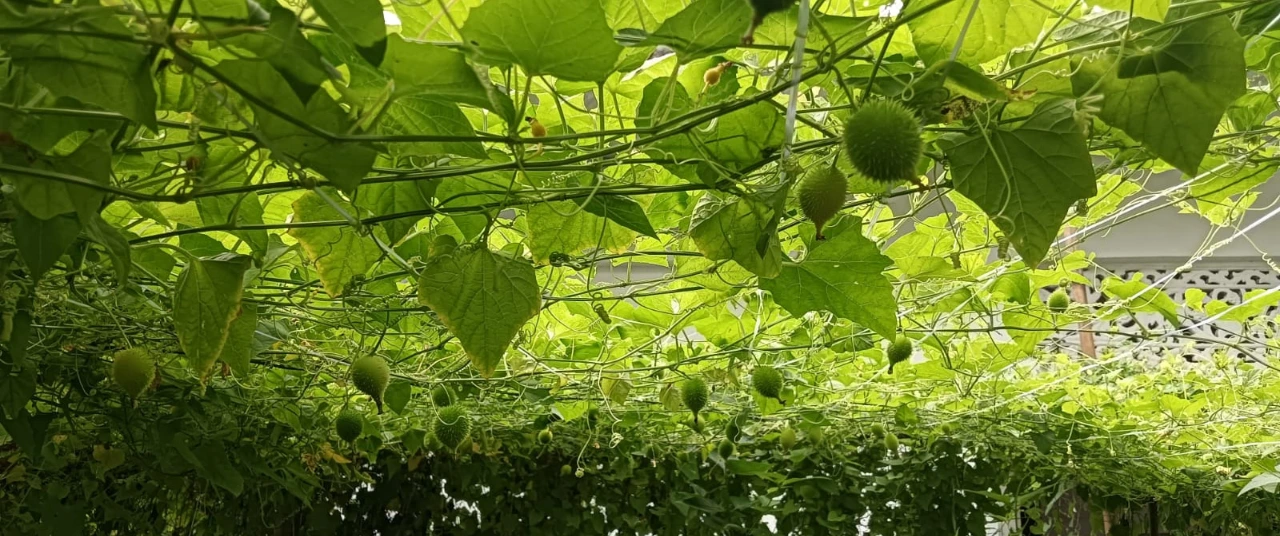
Traditionally a foraged gourd, growing it is not without challenge. Researchers are working to make it more accessible to farmers and consumers
It’s 8:30 am on a rainy August morning when Nosar Bai, 65, is searching roadside bushes in the outskirts of the Jaliya village in Ajmer, Rajasthan. The thing she is looking for is the spine gourd (Momordica dioica), a climber plant with green, spiky, seasonal fruits, also known as kikoda in Rajasthan.
Cooked as a vegetable (find a local recipe for it at the end of this article), the spine gourd is a semi-wild species of flowering plant in the gourd family. It is found in nature with minimal human interference in Punjab, Uttar Pradesh, Rajasthan, Madhya Pradesh, Kerala, and in the Western Ghats of Maharashtra, as well as in other regions of India and Sri Lanka, reaching an elevation of 1,525 metres in the Himalayas.
It is known by different names across India. In Karnataka, it is called madahagalakayi; in Maharashtra, it is known as kartoli and kantola; in West Bengal, it is referred to as bhatkarela and ban-karola; in Andhra Pradesh and Telangana, it is called aakakarakayi; in Tamil Nadu, it is known as pazhupavakkai; and in Kerala, it is referred to as kattu pavakkai/eruma paval. Other names used in different parts of the country include kankoda, meetha karela, kakrol, and kaksa.
For the past 20 years, Nosar Bai has been foraging for spine gourds (also known as spiny gourds) to sell during every monsoon. All year, she has to do absolutely nothing to ensure that the fruits will grow. “Bhagwan bowe hai inhe (it’s God that sows these seeds),” she says. According to her and others from the region who sell foraged spine gourds for a living, the tuber of the plant remains resolutely in place all year, requiring no intervention. As soon as monsoon showers arrive, the plant climbs up swiftly. It thrives in both tropical and subtropical climates and has been described as a hardy plant well-suited to diverse climatic conditions. It can be grown on a wide range of soils and in frost-free areas. As long as there’s rain, there’ll be spine gourds, and if it doesn’t rain for a year, they will still grow the next year amid showers, Nosar Bai says.

More than 550 km away, in Mainpuri, Uttar Pradesh, Omveer Singh cultivates the spine gourd commercially. Singh grows the Indira Kankoda I variety—developed by researchers in Chhattisgarh and released in 2007—which is resistant to all major pests. In India, the fruit (used as a vegetable in the culinary sense) is commercially grown in Odisha, Bihar, Jharkhand, and Maharashtra, along with West Bengal and Karnataka—the two states which lead in its cultivation for sale.

After quitting his job as a salesperson during the COVID-19 pandemic in 2020, Singh decided to turn to farming, deliberately choosing crops that required minimal investment yet offered steady, year-on-year returns. YouTube tutorials helped him learn the basics, and when he came across the spine gourd, it immediately brought back memories of foraging it in the wild during his childhood. That nostalgia, along with its low-effort cultivation, convinced him to grow the spine gourd alongside parwal (pointed gourd). The only recurring costs, he notes, are for manure and neem oil to keep pests away, while the one-time expense of constructing a bamboo support structure—for the tubers to climb—lasts for years.
According to Singh and Nosar Bai, 1 kg of spine gourd can fetch anywhere between ₹80 to ₹200, depending on the time of the season and year. Singh says that cultivating spine gourds in an area of one acre can fetch somewhere between ₹3,00,000 and ₹4,00,000 per season. For him, the returns have been increasing year-on-year.
As soon as monsoon showers arrive, the plant climbs up swiftly.
In Telangana’s Adilabad and Warangal, the gourd has been sold at prices higher than chicken earlier this year and in previous years, reaching as high as ₹500 per kg in 2024 due to its escalating demand and comparatively insufficient production. The other reasons cited for high prices are its limited availability at a specific time of year, as well as its appeal among vegetarians and meat-eaters alike.
“It is not just the fruit that sells. One kilogram of seeds, procured from approximately 10 kgs of fruits, sells for anywhere between ₹3,000 and ₹5,000. The dried roots also sell for about ₹300 to ₹400 per kg. I receive calls from all over the country to ship seeds and roots for medicinal use as well. People have even come to my house or the farm to buy from me directly,” Singh adds.
Also read: A hunt for Goa’s wild ‘monsoon greens’: Foraged veggies that fed generations
The lucrative returns on spine gourd are due to its high nutritional value. “Yeh bimaari kaate hai (It keeps you disease-free),” says Nosar Bai. Along with being rich in vitamins, including vitamin A, vitamin C, and vitamin B9, the fruit contains minerals like iron, magnesium, and potassium. “Rich in fibre, the spine gourd aids in digestion and relieves constipation. It’s a great choice for those with diabetes mellitus, PCOS, hypertension, and obesity because of its high fibre and moisture content and also due to its ability to lower blood sugar levels. Since it is rich in anti-oxidants β-carotene and flavonoids, it can act as an anti-aging agent, and can help fight acne. It’s like a multivitamin pill,” explains Dr Deepti Verma, nutritionist and director, Mastermind Body Global.
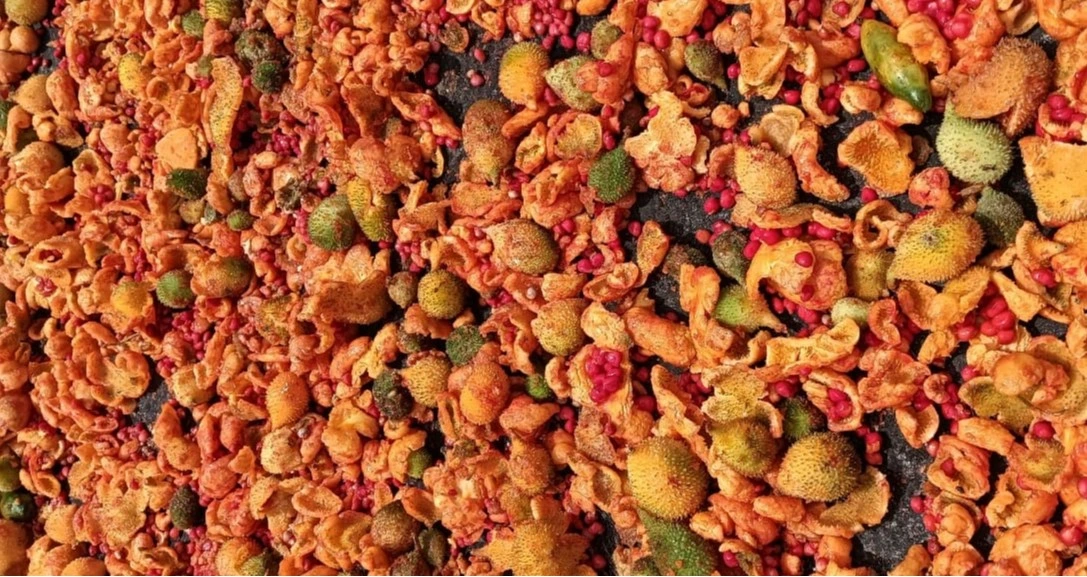
Some reports have documented the medicinal use of the spine gourd in traditional healing practices, too. Tribes in Chhattisgarh have been using the tuberous roots of this plant to treat rheumatism, fever, and diarrhoea, while its seeds are used to treat chest issues.
Also read: The uncertain future of Aarey Forest’s tribal agriculture
Despite its significant economic and nutritional value, and demand in local markets, the spine gourd remains “underutilised and under-exploited”. This is because growing the fruit comes with its own set of challenges. Primarily, there is no conventional propagation technique for large-scale cultivation. It is also a dioecious crop, which means it has separate male and female plants. The male plant only bears flowers, which are essential for pollination but don’t yield any gourds. It’s the female plant that bears both flowers and fruits after being pollinated by the male plant.
When propagated through seeds, one challenge is that the sex of the plants cannot be predetermined. “You need a lot of seeds to ensure cultivation,” says Soumik Banerjee, an independent researcher and practitioner of agro-ecology and heirloom seed conservation. After flowering, a 10% male plant population should be maintained to achieve better fruit yield.
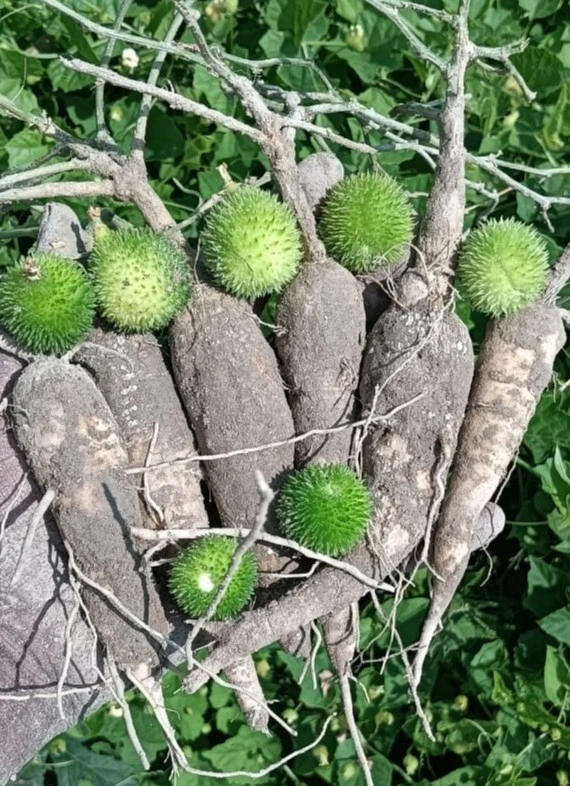
Singh adds that propagation from seeds is also more time-consuming. It takes three months for them to germinate and flower. “Whereas if the propagation is executed through the tuber, it flowers within 30-35 days,” he explains.
Though germination via tubers is faster and provides clarity on the plant's sex, it can be challenging to obtain a sufficient number of plants. “People dig out tubers from the wild, disturbing the plant’s growth in forests and damaging its natural ecosystem,” explains Banerjee.
Also read: In Meghalaya, Mei Ramew cafés keep indigenous recipes, techniques alive
To combat these challenges with propagation, researchers across the country have developed various varieties. For instance, Arka Bharath, identified for commercial cultivation by the experts at the Central Horticultural Experiment Station (CHES) in Karnataka’s Chettalli (a regional station of the Indian Council of Agricultural Research - Indian Institute of Horticultural Research, Bengaluru) is a high-yielding variety.
Researchers found that not only do spine gourd plants sprout only after the onset of the monsoon, they also produce a lower yield with small fruits that weigh between 20 gms–30 gms, resulting in a very low yield of 2-3 kgs per plant.
On the contrary, their Assamese counterpart—the teasel gourd (Momordica subangulata subsp. renigera), a semi-domesticated crop—multiplies more easily, and therefore, can be more cultivated commercially. A single fruit can weigh up to 100 gms, and a yield of up to 8-9 kgs can be procured from one plant. The researchers studied the teasel gourd to produce a high-yielding selection for commercial cultivation. A 2024 study has found that net returns from teasel gourd farming are strikingly promising. The maintenance costs ranged from ₹2,94,460 in the first year to ₹3,65,830 by the fifth year, while the net returns fluctuated between ₹16,49,795 in the first year and ₹14,13,020 by the fifth year.
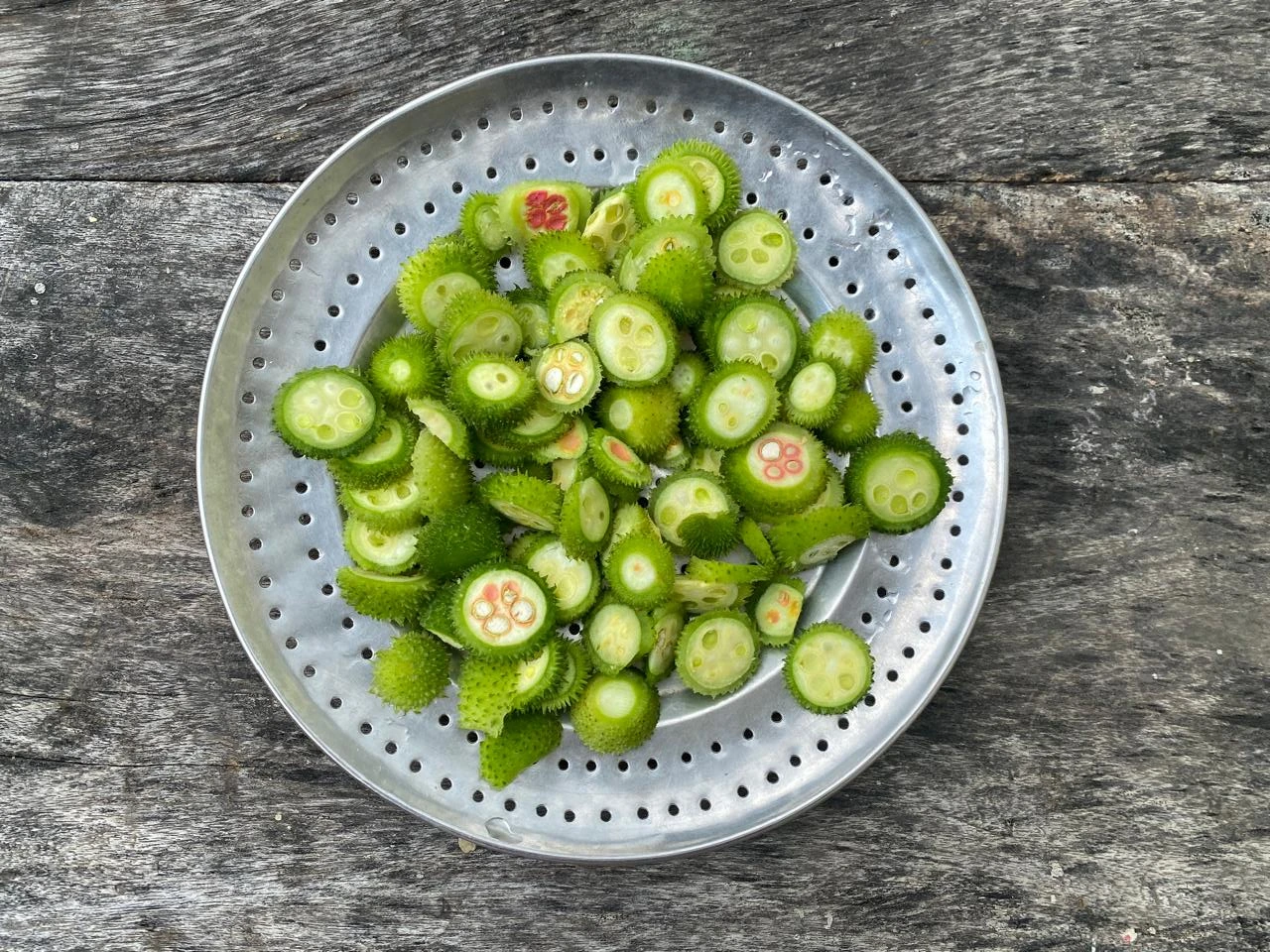
Another successful example stemming from academic research is the Arka Neelachal Shanti variety—a hybrid of the spine gourd developed by crossing it with the teasel gourd. “While the quality of spine gourd is superior, it yields fruits for a shorter time and is difficult to propagate. We’ve crossed two different species to combine the desirable traits of both to develop this variety, which is easy to cultivate and multiply, and yields fruit for a longer duration,” explains Latchumi Kanthan Bharathi, Principal Scientist, division of Crop Improvement, ICAR-Central Tuber Crops Research Institute (ICAR-CTCRI), Thiruvananthapuram. “It is now a super hit with farmers in Odisha, where it was released,” he says.
Bharathi was the principal investigator for the programme that developed Arka Bharath and Arka Neelachal Shanti. The intent behind his research into the subject was widening the food basket and providing greater access to this local ingredient.
Wash the spine gourd fruit thoroughly and leave it to dry. Once dry, cut into round slices. Heat some oil in a pan and add cumin seeds and asafoetida. Sauté some finely chopped onions and slit green chillies. Add the spine gourd, along with spices such as chilli powder, turmeric, and coriander powder. Add salt to taste. Cover and cook on low heat until the gourd is cooked through. Squeeze some lemon on top, mix and season with fresh coriander leaves.

{{quiz}}
Please try another keyword to match the results
